ANNUAL REPORT 2016


 Médecins Sans Frontières Australia
Médecins Sans Frontières Australia




 Médecins Sans Frontières Australia
Médecins Sans Frontières Australia

Médecins Sans Frontières is a private international association. The association is made up mainly of doctors and health sector workers and is also open to all other professions which might help in achieving its aims. All of its members agree to honour the following principals:
Médecins Sans Frontières offers assistance to populations in distress, to victims of natural or man-made disasters and to victims of armed conflict, without discrimination and irrespective of race, religion, creed or political affiliation.
Médecins Sans Frontières observes neutrality and impartiality in the name of universal medical ethics and the right to humanitarian assistance and demands full and unhindered freedom in the exercise of its functions.
3. Médecins Sans Frontières charter
4. Message from the President
6. 2016: Our Year in Review
9. Australian and New Zealand field staff
10. Message from the Medical Unit
Médecins Sans Frontières volunteers undertake to respect their professional code of ethics and to maintain complete independence from all political, economic or religious powers.
As volunteers, members are aware of the risks and the dangers of the mission they undertake, and have no right to compensation for themselves or their beneficiaries other than that which Médecins Sans Frontières is able to afford them.
12. Médecins Sans Frontières Australia 2016 highlights
14. Médecins Sans Frontières projects funded by Australian donors
50. Financial report
Front cover: Australian paediatrician Dr Nikola Morton checks on a newborn baby at Dasht-e-Barchi hospital, Kabul, Afghanistan, March 2016. © Kate Stegeman/MSF
Left: Mothers and their newborn babies at the maternity clinic in Nduta refugee camp, Tanzania, November 2016. © Louise Annaud/MSF
It’s a world that unfortunately seems more discriminatory and unfair than ever before. Refugees, internally displaced people and migrants are seen as threats, rather than people just like us, who have been forced to flee due to circumstance and need assistance. Wars that have been ongoing for years are perceived as ‘normal’ elements of regional instability. Against this backdrop, independent medical humanitarian action has never been more important.
The year began with some relative good news – the huge West African Ebola outbreak was declared over in January. While this was a moment of relief, it was also a moment to reflect on the lessons learned from this outbreak that killed more than 11,000 people. A lack of political will, and a gap in global research and development, are some of the factors that hampered an effective response. Throughout 2016, Médecins Sans Frontières continued to work in the countries affected by the Ebola outbreak, as their health systems gradually recover from the impact of the virus. In Monrovia, Liberia, we ran a 90-bed paediatric hospital, as well as a clinic for Ebola survivors to receive physical and mental healthcare.
South Sudan continued to be a key focus for Médecins Sans Frontières Australia. It was the country where we sent the most field workers, and also the country where we directed the most funding. Donations made through Médecins Sans Frontières Australia contributed a total of $6.6 million towards emergency medical aid in South Sudan in 2016.
While South Sudan may not be top of the media agenda in Australia, it is a country with enormous humanitarian needs. Since its independence in 2011,
it has experienced recurrent crises and 2016 was no exception. Conflict erupted in the capital, Juba, in July, prompting Médecins Sans Frontières to launch several emergency projects. By the end of 2016, more than 1.8 million people were displaced across South Sudan, seeking safety from intense fighting. We provided medical care including surgery for the wounded, and developed mobile treatment models to ensure that people on the move could still receive essential medical care. Preventive healthcare including large-scale measles vaccination campaigns, in addition to routine vaccinations, were carried out in several projects across the country, as well as providing medical care for people who found refuge in neighbouring countries.
Our programs in Nigeria, too, were major recipients of funding through Médecins Sans Frontières Australia. A devastating humanitarian crisis continued to unfold in the northeast of the country, with millions of people displaced by the conflict between Boko Haram and the Nigerian Army. Between April and July, thousands of children succumbed to the deadly combination of malnutrition, measles and malaria in Borno state. Our teams gained rare access to towns that had been cut off from humanitarian aid, and were confronted with appalling rates of malnutrition and mortality. Médecins Sans Frontières epidemiological data helped convince national authorities and international aid agencies of the severity of the emergency, prompting a scaled-up response. Meanwhile our teams provided emergency aid including health and nutritional care, water and sanitation, vaccinations and food and essential non-food items in the capital, Maiduguri, around the state and in the countries hosting refugee populations.
In the Middle East, the catastrophic conflicts in Syria, Iraq and Yemen continued, along with the attacks on civilians and hospitals that have tragically come to characterise these wars. In May world leaders at the United Nations unanimously

In 2016, the world experienced political upheavals, harsher attitudes towards people forced to flee and continuing devastating conflicts.Stewart Condon President Médecins Sans Frontières Australia © Sarah Norton Médecins Sans Frontières Australia
condemned these acts, but they continued unabated. Yemen is now facing a full-blown humanitarian emergency after 18 months of conflict. Two health facilities supported by Médecins Sans Frontières in Yemen were hit by airstrikes or missiles in 2016, killing civilians, including four of our own staff, as well as depriving thousands of people access to medical care. Nonetheless our teams continued to work in 11 hospitals and health centres across the country, while providing support to an additional 18 hospitals.
In late 2016 the offensive to retake Mosul, Iraq, from the so-called Islamic State group displaced hundreds of thousands of people, compounding the insecurity that has affected the country for years. Our teams ramped up capacity, implementing projects across 11 governorates to provide emergency and basic medical care.
In Syria, the siege of Aleppo which began in July saw every functioning hospital in East Aleppo damaged by bombing, some of them more than once. Since 2013, Médecins Sans Frontières had provided drugs, supplies and medical equipment to health facilities in east Aleppo city, however our supply route was cut for the last few months of the siege. At the end
of 2016, Médecins Sans Frontières was providing on-the-ground assistance to evacuees from Aleppo, including medical care and relief items.
Many people affected by the conflict in Syria fled the country’s borders, part of an unprecedented level of global forced displacement. Médecins Sans Frontières teams continue to provide medical aid to the displaced – whether within their own countries, across country borders, or on longer journeys to safety including those making the dangerous voyage across the Mediterranean Sea.
In all, almost one-third of Médecins Sans Frontières projects in 2016 were directed at aiding populations caught in war. When conflict disrupts health systems, infectious disease outbreaks also become more frequent and devastating for the affected populations. Prevention and control strategies were a firm part of our response in Yemen, Nigeria, Central African Republic, South Sudan and Syria.
The work of Médecins Sans Frontières is only made possible with the ongoing

commitment of our supporters. These include those of you who donate your time, including our field workers and volunteers. Thank you for being such an important part of our work, and thanks to our dedicated executive team under the leadership of Executive Director Paul McPhun who have delivered in a truly challenging year. Thanks to the board members who continue to provide good governance oversight, as well as tackling the institutional questions around human resources challenges, growth and how we can continue to best support the field in what they do. Finally, thank you to our very generous donors, including our major donors, trusts and foundations and field partners. Without you our medical humanitarian mission would not be possible.
Dr Stewart M Condon President Médecins Sans Frontières AustraliaMédecins Sans Frontières invested significantly in scaling up capacity to address ongoing and new emergencies in 2016, with support from our Australian executive team.
Central African Republic. Meanwhile the Medical Unit oversaw the publication of essential new guidelines, training and frameworks, which are important factors in maintaining and improving quality of care for all patients.
Paul McPhun Executive Director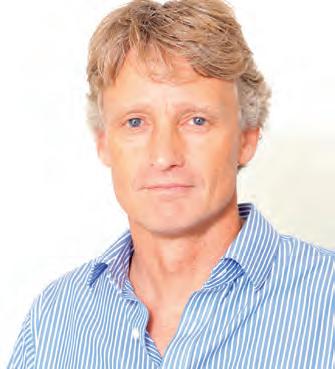
In the Message from the President (page 4), Dr Stewart Condon captures clearly the increasing scope, scale and complexity of medical humanitarian crises afflicting so many people. In response Médecins Sans Frontières has rapidly grown emergency field activities largely in the contexts of Syria, Yemen, South Sudan, Nigeria and the refugee crisis on the borders of Europe. Our efforts to provide emergency medical aid to people affected by these humanitarian emergencies was supported by a highly committed office team in Sydney.
Through the efforts of our Field Human Resources department, Australian and New Zealand field workers filled a total of 203 field positions in 32 countries. The countries most supported were South Sudan, Iraq, Nigeria, Yemen, Libya, Afghanistan, Democratic Republic of Congo, Tanzania, Jordan and Lebanon. This list comprises some of the world’s most severe humanitarian emergencies and indicates the essential contribution made by our field staff.
Médecins Sans Frontières Australia staff worked to improve the quality of medical care provided to our patients, particularly through the Sydney Medical Unit (see message, page 10). The need for high-quality paediatric, women’s health and sexual violence care remains a clear priority, and our medical advisors respond through direct contact with individual field projects and close collaboration with medical and operational colleagues throughout the Operational Centre Paris group. Fifteen field visits were conducted to provide technical expertise in countries including Afghanistan, Uganda, Niger, Nigeria, Mali, Libya, Papua New Guinea and
A medical communications strategy was consolidated and a set of leaflets produced as an internal communications tool to explain our approach to obstetrics and newborn care, paediatrics, nutrition and sexual violence.
As part of our commitment to raising visibility of our patients’ needs, we focused renewed communications efforts on the under-reported conflicts in Yemen and South Sudan. I accompanied a Fairfax media team to South Sudan, where they produced a communications package that helped boost awareness in the Australian community. Likewise, excellent media relations helped achieve the broadcast of a 30-minute documentary on the humanitarian crisis in Yemen with the ABC’s Foreign Correspondent team.
To achieve visibility and public engagement on key humanitarian issues the communications department placed personnel overseas to support operations in countries like South Sudan and Nigeria. The team also published a web package to highlight our medical approach to assisting survivors of sexual violence. The appointment of a Community Engagement Coordinator professionalised our interaction with Australian and New Zealand communities, from fundraisers to academia. Throughout the year, we participated in eight medical conferences and 60 speaking engagements, produced more than 70 pieces of original content and facilitated 178 external media interviews. The new public website was launched in January 2016 with excellent results of increased unique visitation rates and the appointment of a new Social and Multimedia Officer vastly increased engagement on social media.
Médecins Sans Frontières AustraliaThe attack on Médecins Sans Frontières’ trauma centre in Kunduz, Afghanistan in late 2015, and similar attacks in 2016, mostly in Yemen and Syria, inspired advocacy efforts in Australia and New Zealand to build support for UN Security Council Resolution 2286 which insists on the protection of healthcare during conflicts. This issue was also a feature of the analysis provided by our team ahead of the World Humanitarian Summit, which led to our support for the Médecins Sans Frontières Emergency Gap project. This project uses operations-based research to advocate for improved emergency humanitarian capacity both within our organisation and across the humanitarian sector. Our work supporting the Access to Medicines campaign continued through support for the worldwide campaign to amend or scrap the Trans Pacific Partnership Agreement which threatens to increase prices for essential medicines across the Asia Pacific. After years of campaigning and negotiation, first GSK and later Pfizer finally announced they would reduce the price of their pneumococcal vaccine for humanitarian organisations working in emergency settings. This is a significant first step towards increasing lifesaving access to the prevention of pneumonia in children.
Our Finance and Administration team continue to control overhead costs as the organisation grows. New finance, payroll and budgeting systems went live in mid-2016, improving both the efficiency of the team and the ability to report. Information technology support is being reviewed and a new strategic plan developed in 2017. An external review of our Supporter Relations team in late 2016 has resulted in a team restructure and some changes in focus, all designed to improve our in-house one-on-one relationships with our field partners and growing supporter base.
Utilisation of new human resources systems has been identified as increasing employee engagement and satisfaction. The Domestic Human Resources department continues to create effective guidelines to manage job share and parttime staff in the office, as well as working closely with the Sydney Medical Unit to build relationships with local medical
professions to target local staff for Medical Unit roles. In addition to this we will invest in developing strong leadership across the organisation, both for our current leaders, and our future ones.
The executive and board of Médecins Sans Frontières Australia invested significant time and energy in creating a business case to formally enter the New Zealand market, and developed a low-cost means by which we could offer New Zealand supporters the same tax deductible benefits as our long-time Australia supporters. 2017 will be an exciting year when we plan to launch fundraising activities in New Zealand, alongside our regular field recruitment.
Médecins Sans Frontières Australia continued to strengthen its partnership with the Operational Centre Paris, completing in 2016 a multi-year strategic vision for our shared operational ambitions and agreements on specific contributions to our field operations such as our women and child health expertise. We also formalised a joint approach to assess our operational and institutional footprint in the South East and East Asia
Pacific region, in partnership with the Japan and Hong Kong sections.
In 2016, our fundraising activities continued to grow, generating a total of $88.3 million mostly through the regular donations made by our field partners and the generosity of our major donors. I recently attended an event where 200 supporters of Médecins Sans Frontières were invited to share a presentation on our operations in Libya, and discuss the challenges we face. One participant congratulated us on maintaining our independence in the face of such a strongly politicised world, where aid is often offered or withheld based on anything but the needs of patients. In fact it is you, the supporters of our work, who we wholeheartedly thank, for the independence your immense commitment guarantees us to work on behalf of all our patients, irrespective of their circumstances or politics.
Paul McPhun Executive Director Médecins Sans Frontières Australia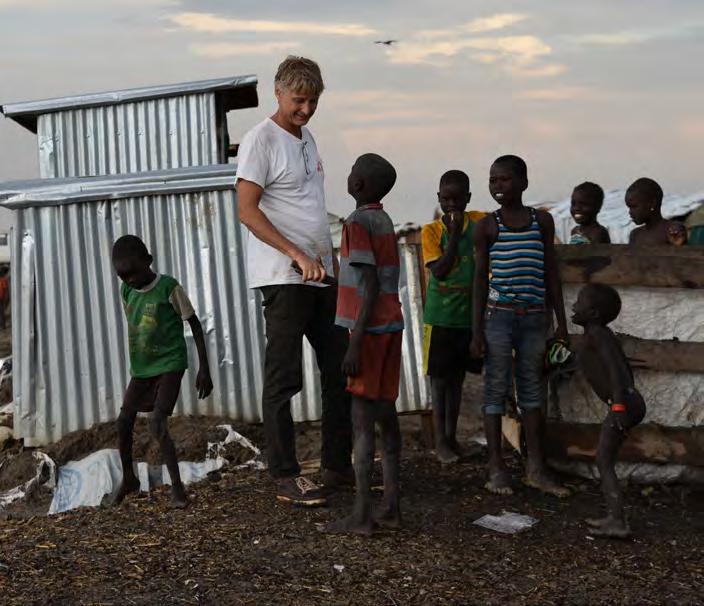
Field workers from Australia and New Zealand filled 203 field roles in 2016, contributing to an international workforce of more than 38,000 people.
AFGHANISTAN
Hannah Rice midwife
Jacqueline Hawker medical doctor
Jacqui Jones nurse
Jeff Fischer general logistician
Katherine Franklin medical doctor
Kelly Drew nurse
Natasha Davies nurse
Rachel Lister medical doctor
Sam Brophy-Williams paediatrician
Shanti Hegde obstetrician-gynaecologist
Siry Ibrahim head of mission
Tim McCulloch anaesthetist
BANGLADESH
Georgina Woolveridge medical doctor
BURKINA FASO
Brian Willett field coordinator
CENTRAL AFRICAN REPUBLIC
Brian Willett head of mission
Caterina Schneider-King administration-finance coordinator
Jordan Amor-Robertson medical doctor
Michael Ward anaesthetist
CHAD
Dennis Lagunay anaesthetist
DEMOCRATIC REPUBLIC OF CONGO
Claire Fotheringham
obstetrician-gynaecologist
Claire Manera field coordinator
Claire Manera general logistician
Johanna White midwife
Peter Mathew surgeon
Raque Kunz general logistician
Sam Templeman nurse
EGYPT
Susie Broughton medical doctor
ETHIOPIA
Alexandra Stewart medical doctor
Cindy Gibb medical team leader
Shaun Cornelius general logistician
FRANCE
Monica Burns field coordinator
GREECE
Carol Nagy medical coordinator
Elspeth Kendall-Carpenter nurse
HAITI
Terri Bidwell medical doctor
INDIA Kelly Wilcox field coordinator
Rose Stephens nurse
Stobdan Kalon medical coordinator
Susan Mundt nurse
Virginia Lee mental health coordinator
IRAQ
Aiesha Ali pharmacist
Andrew Dimitri medical doctor
Devash Naidoo mental health coordinator
Elisha Swift midwife
Emma Clark medical doctor
Graham Baker general logistician
Jeanne Vidal water and sanitation logistician
Jessa Pontevedra nurse
Jessica Chua medical doctor
Jody Clouten water and sanitation logistician
Kimberley Hikaka logistics team leader
Luke Maes nurse
Robert Onus field coordinator
Robert Onus logistics team leader
Rose Stephens nurse
Sita Cacioppe field coordinator
Sita Cacioppe nurse
Stephanie Davies HR officer – regional
Vanessa Cramond medical coordinator
Vino Ramasamy administration-finance coordinator
ITALY
Rachel Tullet medical doctor
Shaun Cornelius general logistician
JAPAN
Carol Nagy head of mission
JORDAN
Anita Williams epidemiologist
Gregory Keane regional mental health referrent
Joseph Pickett general logistician
Judith Forbes anaesthetist
Loraine Anderson psychologist
Natalie Thurtle medical doctor
Nicole Campbell nurse
Roger Athersuch medical scientist
KENYA
Mike O’Connor medical doctor
Nikola Morton paediatrician
Rachel Lister medical doctor
KYRGYZSTAN
Marie Reyes nurse
LEBANON
Amy Neilson medical doctor
Chatu Yapa medical doctor
Kezia Mansfield medical doctor
Louisa Cormack field coordinator
Prue Coakley field coordinator
Shelagh Woods head of mission
LIBERIA
Helle Poulsen-Dobbyns medical coordinator
Kaye Bentley administration-finance coordinator
Skye Giannino nurse
LIBYA
Andrea Atkinson medical doctor
Eileen Goersdorf nurse
Grace Yoo pharmacist
Janet Coleman midwife
Jessica Dwyer nurse
Joseph Pickett general logistician
Kimberley Hikaka general logistician
Kriya Saraswati general logistician
Kylie Gaudin general logistician
Nicole Ganderton nurse
Roisin Gormley midwife
Sam Templeman medical doctor
Shanti Hegde obstetrician-gynaecologist
Terry Coffey general logistician
MALAWI
Anita Williams field administrator
Monica Burns field coordinator
Rebecca Bloor pharmacist
MALAYSIA
Robert Gardner administration-finance coordinator
MYANMAR
Roslyn Brooks medical doctor
NIGERIA
Anne Taylor head of mission
Colin Chilvers anaesthetist
Diana Wellby obstetrician-gynaecologist
Eric Boon general logistician
Helle Poulsen-Dobbyns field coordinator
Jananie Balendran epidemiologist
Jennifer Craig general logistician
Jennifer Duncombe epidemiologist
Kriya Saraswati general logistician
Lauren Cooney head of mission
Megan Graham administration-finance coordinator
Miho Saito nurse
Rachna Shankar anaesthetist
Simon Black logistician-electrician
Siry Ibrahim field coordinator
Stephanie Sarta general logistician
Tim McCulloch anaesthetist
PAKISTAN Malcolm Hugo mental health coordinator
Narelle Raiss nurse
Shaun Cornelius general logistician
Susie Broughton medical doctor
PALESTINE
Loraine Anderson psychologist
Paul Chan anaesthetist
PAPUA NEW GUINEA
Florence Bascombe nurse
Hugo De Vries construction logistician
Kimberley Hikaka general logistician
Petra van Beek administration-finance coordinator
SIERRA LEONE
Debra Fincham midwife
Paras Valeh epidemiologist
SOUTH SUDAN
Adrian Thompson field coordinator
Alexandra Stewart medical doctor
Allen Murphy field coordinator
Amy Neilson medical doctor
Brigid Buick health promotion
Corrinne Kong administration-finance coordinator
David McGuinness medical team leader
David McGuinness nurse
Emma Parker nurse
Grace Yoo pharmacist Harriet Barker nurse
Jai Defranciscis nurse
Jessica Paterson administration-finance coordinator
Jessie Watson administration-finance coordinator
Jocelyn Chan epidemiologist
John Cooper general logistician
Katherine Franklin medical doctor
Kay Hodgetts medical doctor
Miho Saito midwife
Nadim Cody medical doctor
Neville Kelly general logistician
Nicole Ganderton nurse
Paras Valeh epidemiologist
Rachel Sun pharmacist
Rachel Tullet medical doctor
Rob Baker logistics team leader
Roisin Gormley midwife
Sam Templeman nurse
Susan Bucknell logistics team leader
SWAZILAND Keith Cavalli logistics team leader
SYRIA
Declan Overton logistics coordinator
Janine Issa field coordinator
Sarah Dina mental health coordinator
TAJIKISTAN Prudence Wheelwright midwife
TANZANIA
Amanda Lam nurse
Brian Willett field coordinator
David Nash head of mission
Emily McGrath nurse
Jananie Balendran medical doctor
Rachel Marsden field coordinator
Raque Kunz general logistician
Warren Grieef general logistician
UGANDA
Adelle Springer epidemiologist
Alice Morgan mental health coordinator
Carmel Morsi nurse
Rob Baker general logistician
Stephanie Davies administration-finance coordinator
UKRAINE
Aiesha Ali pharmacist
Sita Cacioppe field coordinator
UZBEKISTAN
David Lister medical doctor
Elspeth Kendall-Carpenter nurse
VARIOUS
Jennifer Duncombe medical coordinator
YEMEN
Emma Parker nurse
Jim Cutts general logistician
Helmut Schoengen anaesthetist
Jessa Pontevedra nurse
Jessica Chua anaesthetist
Jessica Chua medical doctor
Jessica Ramsay medical scientist
Jonathan Stacey anaesthetist
Kate Tyson obstetrician-gynaecologist
Kyla Ulmer nurse
Mathew Zacharias anaesthetist
Nikola Morton medical doctor
Robert Onus field coordinator
Rodney Miller administration-finance coordinator
Suzel Wiegert nurse
Strengthening tools and frameworks to ensure that patients receive the same level of high quality care across all our paediatric, women’s health and sexual violence projects was the focus for the Médecins Sans Frontières Australia Medical Unit in 2016.

In 2016 the Medical Unit continued its primary responsibility to support the care of women and children in our field projects around the world. Through our team of paediatricians, midwives and obstetrician-gynaecologists, we aim to ensure that women and children receive the highest level of medical care possible within the contexts where we work.
There are various ways we meet that primary responsibility of patient care. The support can be very direct, such as a phone call with one of our doctors in the field who needs advice on a particularly difficult case. We also provide big-picture support, such as advising the operations department in Paris about the medical needs, and strategies to address these needs, when new projects are being established or when planning for the future of current projects.
A key role, and one that we focused on in 2016, is developing tools that underpin both that direct and indirect support to patient care. In 2016, our comprehensive paediatric guidelines were rolled out in various field projects, ensuring that patients receive standardised, evidencebased care across projects. In 2016, we also released our first neonatal guidelines, which will serve as the guiding tool for all projects where we treat newborns. We continually review and update guidelines based on the latest evidence adapted to our settings, ensuring that they remain as relevant and useful as possible.
Our new paediatric framework for critically ill children was also implemented in 2016. This framework describes everything about how care needs to be organised in a hospital, from patient flow and triage systems, to equipment and staffing needs, to review and evaluation procedures. This is extremely valuable in paediatric hospitals,
where typically a huge number of patients arrive over the first few hours of daylight, and you need to quickly identify which children need immediate attention. In 2016 this framework proved very helpful in our hospital in Borno State, Nigeria, where it certainly contributed to some improved patient outcomes such as reduced mortality and length of hospital stay.
The crisis in Borno State, caused by the conflict between Boko Haram and the Nigerian Army, was a focus of our work in 2016. With more than 1.8 million people displaced, and hundreds of thousands of children facing malnutrition and lack of medical care, it is one of the most severe contemporary humanitarian crises. We opened new nutrition and treatment centres, expanded our existing ones, and gained new access to hard-toreach areas of the state, such as Bama, where we found shockingly high levels of malnutrition. Overall, our teams provided more than 200,000 outpatient consultations in Borno State, while more than 10,000 children received treatment in our therapeutic feeding programs. Worldwide, more than 44,000 children under five with severe acute malnutrition were admitted to our therapeutic feeding programs in seven countries – the highest figure in five years. We also supported maternal healthcare in two locations in Borno, where we provided more than 27,000 antenatal consultations and 3,000 deliveries across the year. We also partnered with other organisations to ensure survivors of sexual violence receive the care they need.
Another focus in 2016 was the opening of Médecins Sans Frontières’ first project providing cervical cancer prevention, screening and treatment, based in a slum area in Manila, Philippines. We vaccinated
25,000 girls aged 9 to 13 against human papilloma virus, to prevent cervical cancer, with the second dose to be provided this year. The project will also make use of simple, relatively inexpensive screening techniques that can be done by midwives or doctors without the use of sophisticated laboratory equipment. In 2017, a cervical cancer project will be rolled out in a very different context, in rural Malawi.
In 2016 we experienced a substantial increase in the number of babies delivered in our projects, and a consequent increase in the number of newborns receiving assistance. We supported 61,000 deliveries, which represents a 20 per cent increase on 2015. Notably, almost one third of these deliveries were in Afghanistan where we run our biggest maternity program. Our approach aims to focus on the mother-baby ‘dyad’ (unit) during labour and the first minutes after delivery, because the health of both mother and baby are so closely intertwined. Providing good monitoring during labour, responding quickly if things go wrong, and providing care for the newborn immediately after delivery –

these interventions save the lives of many mothers and babies.
To reduce maternal mortality, women need access to both safe delivery care and safe abortion care. The latter encompasses emergency care for complications of unsafe abortion, family planning, and termination of pregnancy on request. In 2016, the number of terminations on request increased and we will continue efforts to offer this service alongside family planning, as unsafe abortion is the only preventable cause of maternal mortality.
Providing ongoing training to our national and international staff is another key element in improving quality of care. In 2016 we finalised development of a midwife training package for our international midwives, who can then train national staff in the field, adapting it to the specific context. We also designed a standardised paediatric training course in emergency paediatric care, based on our new guidelines, which is aimed at nurses and doctors who are not
paediatric specialists. In 2016, around 100 staff participated in this five-day simulation-based course, in Mali, France, and Democratic Republic of Congo. A neonatal training course is being implemented in 2017.
Sexual violence care is an increasingly important component of our work, with more than 3,000 survivors offered medical and psychological care through the year. In 2016 Médecins Sans Frontières implemented an e-learning program for response to sexual violence, giving our staff access to training online. Training is crucial to help our teams gain an understanding of this complex issue.
2016 was a busy and productive year for the Medical Unit, and with some of our key medical figures showing no sign of slowing, 2017 promises to be just as challenging.
Dr Myrto Schaefer Head of Medical Unit Médecins Sans Frontières AustraliaIn 2016, Australians and New Zealanders filled 203 field roles in 32 countries.
The 2016 income of Médecins Sans Frontières Australia totalled AUD$94.3 million. Of this AUD$88.3 million was income generated from fundraising activities. This is an increase on the 2015 level of fundraising income and represents continuing increased support from the Australian public. More than 123,000 Australians participate in the field partner program, contributing on a monthly basis to Médecins Sans Frontières Australia, and another 32,000 provide occasional gifts.
Spending on Social Mission was 81% of total expenditure, which is line with prior years. Consistent with previous years this is split between Operational Centre Paris and Operational Centre Geneva.
Our investment policy within Australia remains consistent with previous years. Short-term deposits are used to maximise interest, minimise risk and ensure flexibility and accessibility of funds when required.
Médecins Sans Frontières continues to rely on the support of volunteers both in the field and in the office. The estimated total salaries forgone by field staff for 2016 is $4,336,000 (compared with $3,368,000 in 2015) and for office volunteers is $154,000 ($156,000 in 2015).
Médecins Sans Frontières field projects are run by five operational centres (Amsterdam, Barcelona, Brussels, Geneva and Paris). The Australian section is an official partner of the Paris operational centre, and Australian donors contribute to funding projects run by both the Paris and Geneva operational centres. Médecins Sans Frontières Australia also provides human resources to all operational centres’ projects.
OVERALL TOTAL: 64,444,746
*All figures are in Australian dollars
This section describes those projects supported by the generous donations made to Médecins Sans Frontières Australia in 2016. It also includes stories from field workers recruited by Médecins Sans Frontières Australia. For a complete record of Médecins Sans Frontières’ work in 2016, including projects funded through other Médecins Sans Frontières sections, please refer to the 2016 International Activity Report: www.msf.org/international-activity-reports.
Notes:
* “Funding” refer to Médecins Sans Frontières Australia’s contribution to the country’s projects in 2016. All amounts are in Australian dollars.
* “Field staff” refers to the total number of field staff in projects run by Operational Centre Paris and Operational Centre Geneva in 2016.
* “Project locations” refer to those projects funded by Médecins Sans Frontières Australia.
 Médecins Sans Frontières Australia
Médecins Sans Frontières Australia
AFGHANISTAN
KEY ACTIVITIES: Maternal healthcare, newborn care
FIELD STAFF: 456
FUNDING: $1,500,000
KEY MEDICAL FIGURE: 15,627 babies delivered in Dasht-e-Barchi

After a US military airstrike destroyed the trauma centre in Kunduz in October 2015, killing 42 people, Médecins Sans Frontières engaged in negotiations with all parties to the conflict regarding the neutrality of medical care. At the end of 2016, commitments had finally been obtained that our staff and patients would be respected, and care could be provided to everyone in need, regardless of their ethnicity, political beliefs or allegiances. Although hard to guarantee in an active conflict zone, Médecins Sans Frontières believes these commitments will allow it to evaluate the possibility
of resuming trauma care activities in Kunduz in 2017.
Médecins Sans Frontières collaborates with the Ministry of Public Health to provide around-the-clock maternal healthcare at Dasht-e-Barchi hospital, the only facility for complicated deliveries in this growing district of Kabul. Our teams run the labour and delivery rooms, an operating theatre for caesarean sections and other complicated deliveries, a recovery room, a 30-bed maternity unit, a 20-bed newborn unit which provides specialist care for sick newborns, and a

NAME:
Kara Blackburn
FROM: Brisbane, Queensland
FIELD ROLE:
Women’s health advisor, Kabul, April 2016
I was asked to visit the Dasht-e-Barchi project [in April 2016] because the number of deliveries had doubled since the project opened just over a year ago! We wanted to review the challenges of upholding quality of care under the sheer pressure of more and more women coming to deliver in our facility. In the last 24 hours of my visit the team managed 60 deliveries – in any hospital this is a huge volume, and yet everyone kept up the pace; striving to provide a good quality of care. I was really impressed. The increase in deliveries in Dasht-e-Barchi hospital is related to a number of factors, including the hospital offering free, quality care, and that there simply aren’t enough maternity beds in Kabul. Postpartum care is one of the areas of service we have been strengthening. It is not only part of safe delivery care; it can also contribute to prevention of future complications.
five-bed ‘kangaroo mother care’ room. Our teams also administer vaccinations and run the laboratory, blood bank and sterilisation unit.
During 2016, teams assisted 15,627 deliveries, almost 27 per cent of which were complicated cases. The team is now aiming to increase referrals for simple deliveries, in order to focus on complicated cases and maintain a high quality of care.
Working at full capacity, the newborn unit admitted 1,342 babies with complications such as sepsis, hypoglycemia and birth asphyxia [loss of oxygen around the time of birth].
Left: Dasht-e-Barchi’s Kangaroo Mother Care Unit. © Kate Stegeman/MSF Kara Blackburn, left, with Afghani midwife Aqila. © Ruth Molloy/ MSFARMENIA
KEY ACTIVITIES: Tuberculosis care
FUNDING: $300,000
FIELD STAFF: 58
KEY MEDICAL FIGURE: 66 people receiving innovative TB treatment
Médecins Sans Frontières focuses on implementing new regimens for patients with multidrug-resistant tuberculosis (MDR-TB) in Armenia, which has one of the highest rates of the disease in the world.
Tuberculosis continues to be a major public health concern in Armenia, particularly drug resistant forms of the disease. Around 11 per cent of new TB cases and 47 per cent of previously treated cases are drug-resistant. Around 10 per cent of MDR-TB patients have extensively drug-resistant TB, which is the most difficult to treat. The main challenge when treating MDR-TB is the length and toxicity of the regimen, which
involves taking up to 20 tablets every day for two years, and months of daily injections, with side effects including permanent hearing loss, suicidal depression and psychosis.
Armenia was one of the first countries in the world to authorise the use of two new TB drugs, bedaquiline and delamanid, which promise to be less toxic and more effective. In 2016, this new treatment
approach continued to be the focus of Médecins Sans Frontières activities in Armenia, while care of patients on standard MDR-TB treatment was handed over to the Armenian authorities. Between January and December 2016, 66 MDR-TB patients started the new regimen, and a total of 79 patients were under treatment by the end of the year.
In 2016 our team also began screening for hepatitis C among people with MDRTB, with one patient receiving treatment. The results are very encouraging so this pilot project will be extended to about 30 patients.
NAME:
Shaun Cornelius
FROM: Wellington, NZ
FIELD ROLE: Logistician on the MV Aquarius, a search and rescue ship operated by Médecins Sans Frontières and SOS Méditerranée, October to December 2016

The people coming onto the MV Aquarius are cold, tired, disoriented and in shock. Many are soaked in gasoline which is burning their skin, and are intoxicated from the fumes. They have trouble standing on the heaving, slippery deck. Médecins Sans Frontières and other crew steady them, take the life jackets off and guide them down a chain of hands around towards the stern deck. The medics are flat out triaging patients and providing emergency treatment. They will be busy for many more hours treating skin burns and providing critical care for people who have inhaled seawater and gasoline.
As a logistician, I keep all the Médecins Sans Frontières equipment and structures on board in good working condition. This includes the shelter structures, toilets, showers and plumbing, drinking water filters, radios, computers and medical equipment. I am also responsible for the stocks of emergency kits and food we provide to our passengers. I carry out the re-order of supplies. During and
after a rescue I manage the movement of people around the ship and coordinate the food distribution process. I am also always looking for ways to improve the facilities we have on board.
Shaun Cornelius on board the Aquarius. © Laurin Schmid/ SOS Mediterranee YEREVAN AZERBAIJAN TURKEY Project locations funded by Australian donorsKEY ACTIVITIES: Hepatitis C FUNDING: $540,000
FIELD STAFF: 25
Médecins Sans Frontières launched a hepatitis C program in Cambodia in May 2016, offering the first free treatment in the country for the blood-borne virus.
Although the prevalence of hepatitis C is unknown, it is estimated that between 2 and 5 per cent of the population is infected. The project is based at the Preah Kossamak hospital in Phnom Penh. The team started by screening HIV patients at the hospital for co-infection.

In October, screening was expanded to include patients referred by the hospital’s hepatology department. The results indicated that only a small number of HIV patients were co-infected with hepatitis C. By the end of December, 307
KEY MEDICAL FIGURE: 307 patients receiving hepatitis C treatment
patients were on treatment and 183 were on the waiting list.
One of the findings from the first six months of the project was that a large percentage of hepatitis C patients are older. The median age of patients is 55, and 91 per cent are over 40 years old. Fifty per cent of patients were found to have advanced disease, which is associated with severe damage to the liver.
Médecins Sans Frontières’ hepatitis C clinic in Preah Kossamak Hospital, Phnom Penh. © Dean Irvine
CAMEROON
KEY ACTIVITIES: Maternal healthcare, nutrition care, surgery, water and sanitation
FIELD STAFF: 702
Project locations funded by Australian donors
Médecins Sans Frontières scaled up activities in Cameroon in 2016 in response to a large influx of people displaced by violence from neighbouring Nigeria.
Since 2011, violent attacks by Boko Haram and the counterinsurgency operations of the Nigerian army have forced hundreds of thousands of people from northeast Nigeria to seek refuge in Cameroon, Chad and Niger. By the end of the year, there were around 86,000 refugees and 198,000 internally displaced people in Cameroon.
In response, Médecins Sans Frontières scaled up its activities in several locations in the north of the country, providing
This little girl arrived in Minawao refugee camp with her mother and two siblings, after her father died and her village in Nigeria was taken by Boko Haram. Her mother saved up for a motorcycle to make the journey to safety in the camp.

healthcare, including maternity care and nutritional support, in the UNHCRadministered Minawao camp. Teams carried out 58,147 consultations during the year. We also focused on improving water and sanitation, trucking in 3,000 cubic metres of water per week and assisting with the construction of 32 kilometres of pipes to create a permanent solution to the scarcity of water in the camp. Médecins Sans Frontières had been running an inpatient therapeutic feeding centre and the paediatrics
FUNDING: $2,100,000
KEY MEDICAL FIGURE: More than 58,000 consultations provided
department at Mokolo hospital, but handed over these activities to another international organisation in May.
In Kousseri, on the Chadian border, Médecins Sans Frontières supported the surgical ward at the district hospital, performing caesarean sections and emergency interventions. Teams also provided nutritional and paediatric care at the hospital and outpatient consultations in three health centres on the outskirts of the city. In addition, Médecins Sans Frontières trained Ministry of Health staff in the management of large influxes of wounded patients.
© Pierre-Yves Bernard / Médecins Sans Frontières MINAWAO MOKOLOKEY ACTIVITIES: HIV/AIDS care, maternal healthcare, paediatrics, primary healthcare, secondary healthcare, sexual violence care, vaccinations
FUNDING: $3,000,000
FIELD STAFF: 1,146
KEY MEDICAL FIGURE: 99,000 children vaccinated in Berberati
Ongoing political unrest and violence have resulted in a protracted humanitarian crisis in the Central African Republic (CAR). Despite relatively peaceful democratic elections in early 2016, the situation remains extremely concerning.
Amid shifting frontlines, thousands of people were killed, wounded or displaced as armed groups fought to take control of territory. Two Médecins Sans Frontières workers paid the ultimate price and lost their lives while doing their jobs.
Humanitarian needs are immense. In late 2016, 2.3 million people, or about half the population, were depending on humanitarian aid to survive. People are regularly targeted in attacks and forced to move, with one in five CAR citizens displaced inside or outside national borders.
Sporadic fighting and violence continued in the capital, Bangui, in 2016. Médecins Sans Frontières has run a surgical project in the capital since 2013, and conducted 3,700 surgical procedures in 2016. Our teams also provide medical and psychological care for victims of sexual violence, conducting 620 consultations throughout the year. Meanwhile, in the predominantly Muslim neighbourhood of PK5, Médecins Sans Frontières conducted more than 30,000 outpatient consultations.
In Berbérati, CAR’s second-largest city, our teams continued to support the regional university hospital and four outlying health centres to improve access to primary and secondary healthcare. At the hospital, we supported paediatric care, treatment for HIV, mental health and health promotion services, medical and
psychological care for victims of sexual violence, as well as the laboratory. In the health centres, Médecins Sans Frontières supported paediatric and sexual and reproductive health, as well as nutrition services. Overall in 2016, 4,232 children were admitted to hospital, and 1,688 deliveries were assisted. Our teams also trained medical staff to ensure that the quality of care is maintained after the team hands over its medical activities in Berbérati to the Ministry of Health in 2017.
Médecins Sans Frontières’ paediatric project in Bria (Haute-Kotto) provides healthcare, including HIV and TB treatment, to children under the age of 15. There were more than 3,000 admissions to the hospital, and 42,000 outpatient consultations. Neonatal consultations increased by about 70 per cent, to more than 580 in 2016. When armed conflict erupted in November, our medical teams treated around 140 wounded people in the hospital.
In Paoua (Ouham Pendé), Médecins Sans Frontières has provided secondary health care in collaboration with the Ministry of Health since 2016. The project now focuses on paediatrics, HIV and tuberculosis programs, as well as continued support of peripheral health centres. In 2016, more than 70,000 outpatient and 12,000 emergency room consultations were provided. By the
end of 2016, 1,021 people were receiving ongoing antiretroviral therapy for HIV. The project in Carnot (Mambéré-Kadéï) also continued, providing hospital and outpatient care for adults and children. More than 2,800 children were admitted to hospital and 52,000 outpatient consultations provided.
Immunisation rates in CAR have plummeted due to the ongoing political and military crisis. Médecins Sans Frontières launched a vast multi-antigen vaccination campaign in collaboration with the Ministry of Health. In Berbérati, 99,000 children under five were protected against polio, diphtheria, tetanus, whooping cough, measles, hepatitis B and certain strains of pneumonia. Children were also vaccinated in Paoua, where the minimum target of 80 per cent coverage was achieved, despite regular interruptions due to violence.
Humanitarian needs are immense. In late 2016, 2.3 million people, or about half the population, were depending on humanitarian aid to survive.
CHAD
KEY ACTIVITIES: Malaria care, maternal healthcare, nutrition care, paediatrics, primary healthcare
FIELD STAFF: 459
FUNDING: $1,800,000
KEY MEDICAL FIGURE: 110,000 children protected against malaria
In 2016, thousands of people in the Lake Chad region were forced to flee their homes due to violent clashes between the armed group Boko Haram and Chadian military forces. Chad remains one of the poorest countries in the world, with a lack of qualified medical personnel and a high child mortality rate.

Since 2015, Médecins Sans Frontières teams have been supporting the management of sexual and reproductive healthcare at the regional hospital in Bol, assisting more than 400 deliveries, including over 80 caesarean sections, and admitting more than 1,200 patients to the paediatric ward this year.
We also run a mobile clinic from Bol, providing basic healthcare and mental health support to displaced people and the local population. Most of the
medical conditions are linked to the precarious living conditions and poor sanitation. In 2016 the mobile clinic provided around 20,700 primary health consultations, a third of which were for children under five. In addition, the mobile team screened over 6,600 children for malnutrition and treated more than 500 for severe acute malnutrition.
In Moissala, Mandoul region, Médecins Sans Frontières runs a prevention, detection and treatment program for
malaria, focusing on children and pregnant women. Around 2,300 children were admitted to Moissala hospital’s malaria unit, while 43,000 children and 7,500 women were treated for malaria in health facilities supported by our teams in the district. Four rounds of seasonal malaria chemoprevention were administered in 2016, reaching more than 110,000 children with antimalarial drugs each time. During the malaria peak in the autumn, we organised spraying activities to reduce the spread of the disease. The team also gave catch-up vaccinations to children who had not received their routine immunisations.
A young woman is carried to the Médecins Sans Frontières mobile clinic near Bol after travelling on a horse and cart for over 30km. © Dominic Nahr LIBYA NIGER NIGERIA SUDAN SOUTH SUDAN MOISSALA BOL Project locations funded by Australian donorsKEY ACTIVITIES: Tuberculosis care
FUNDING: $300,000
FIELD STAFF: 58 KEY MEDICAL FIGURE: 66 people receiving innovative TB treatment
In 2016 Médecins Sans Frontières continued to support maternal and child health in the Hambol region of Côte d’Ivoire.
The political and military crises of 2002-2010 have taken a severe toll on the Ivorian health system, which is now one of the weakest in Africa with only one doctor and five midwives per 10,000 people. As the maternal mortality rate is very high, the Ministry of Health has made maternal healthcare one of its main priorities, offering free care to all pregnant women. However, budgetary restrictions, drug shortages and a lack of trained health personnel, among other factors, continue to hamper access to
quality medical services for women and young children.
In the Hambol Region, Médecins Sans Frontières runs a maternal and neonatal healthcare project in collaboration with the Ministry of Health. A survey by Epicentre, Médecins Sans Frontières’ epidemiological research centre, found that the maternal mortality ratio is particularly high in this region – an estimated 661 deaths per 100,000 live births. The team aims to improve the management of obstetric and neonatal
emergencies in this rural setting by supporting the Katiola referral hospital and three primary health centres in the region. We support these facilities by providing additional personnel and medical supplies and by facilitating an efficient referral system for complicated deliveries, while implementing a training, coaching and supervision program for Ministry of Health staff.
Every month in 2016, an average of 350 deliveries were assisted in Médecins Sans Frontières-supported facilities, 55 newborns were admitted to the neonatal ward and 50 caesarean sections were performed at Katiola hospital.
NAME: Dr Claire Fotheringham

FROM: Brisbane, Queensland
FIELD ROLE: Obstetriciangynaecologist, Masisi, March to May 2016
Masisi is in the north of DRC and it looks like Switzerland. It rains a lot so it’s difficult to get in because the roads aren’t paved. The day that I arrived we took a car from Goma until the first landslide. We walked across it to be picked up by a second car. We were then blocked by another landslide, so we ended up on motorbikes. And when the motorbikes couldn’t go any further, we started walking. The 80km took almost the entire day. This makes it difficult in terms of transferring patients. Médecins Sans Frontières runs 4WDs as ambulances, yet we still face problems. One night, a pregnant woman came by what is commonly known as “helicopter”. She was put on a stretcher and carried by the men of the village. This involved 20 or 30 men taking turns to carry the stretcher. As the ‘helicopter’ approached the hospital, the woman had to deliver. It had taken five to six hours and she couldn’t wait any longer. The woman was alright but the baby wasn’t breathing. I tried resuscitation and we did our
absolute best to save the baby but it wasn’t possible. But the mother’s life was potentially saved by the superhuman effort of those men to bring her to us.
Dr Claire Fotheringham en route to Masisi. © MSFKEY ACTIVITIES: HIV/AIDS care, malaria care, nutrition care, paediatrics, response to outbreaks, surgery
Poor infrastructure and inadequate health services continue to restrict access to medical care in the Democratic Republic of Congo (DRC).
Patients face financial barriers to treatment and health workers are paid little or no money. Moreover, large parts of the country are difficult to access due to logistics or security. The eastern provinces remain insecure, as the Congolese army and several armed groups fight for control of resource-rich territory.
In Tanganyika province, part of the former Katanga province, Médecins Sans Frontières supported two hospitals and several health centres in Manono and Kabalo during a nutrition emergency. By late August, the Kabalo project had closed, but in Manono more than 6,000 children were admitted to the paediatric unit, 1,400 to the inpatient feeding program and 4,900 were treated at ambulatory feeding centres. Measles outbreaks are recurrent in this area, and 2016 was no exception. In Nyunzu health zone, Médecins Sans Frontières established an 18-bed measles treatment centre and vaccinated more than 75,000 children against the disease. At the end of 2016, there was an escalation in violence between different ethnic groups in Tanganyika and the team treated over 200 wounded patients in the hospital.
Médecins Sans Frontières continued to work to bring cholera under control in four health areas around Kalemie. The project began in 2011 and has taken a multifaceted approach to cholera prevention including cholera vaccinations and improving water supply. In 2016, a 500m3 water tank was donated
to the water authority, and overall management of the project was handed over to local authorities.
North Kivu
Further north, in North Kivu province, Médecins Sans Frontières has supported Rutshuru Hospital since 2009. In 2016, more than 7,500 surgical procedures were performed, and 7,600 children were admitted for malaria treatment. More than 26,000 consultations were conducted in the emergency room. Médecins Sans Frontières also began the process of handing over activities in the hospital to the Ministry of Health. A substantial reconstruction of the facility has begun, which is due for completion by the end of 2017.
Between March and June, we responded to a nutrition emergency in camps for displaced people in Lubero. Our teams systematically screened children for malnutrition, and established two intensive treatment units for children with severe acute malnutrition. More than 600 children were treated during the four-month intervention.
In Goma, Médecins Sans Frontières continued to support the Ministry of Health to provide HIV/AIDS screening and treatment in five health facilities. More than 17,000 people were screened in 2016, while more than 2,600 people with HIV/AIDS receive antiretroviral treatment and ongoing monitoring. Médecins Sans Frontières also responded
FUNDING: $4,258,000
FIELD STAFF: 1,221
KEY MEDICAL FIGURE: 7,500 surgical procedures in Rutshuru
to a cholera outbreak, treating more than 700 patients.
Lubumbashi
Further south, in Lubumbashi, Médecins Sans Frontières supported health facilities to treat people wounded in violent protests. Also in Lubumbashi, our teams responded to a cholera epidemic, mainly deploying logistical support for patient care. In December, we participated in the development of a mass casualty plan for Lubumbashi, including supporting eight health facilities and a hospital, as well as staff training on triage and stabilisation of patients.
An outbreak of yellow fever hit all the provinces bordering Angola in 2016. Médecins Sans Frontières France supported epidemiological surveillance by setting up an SMS early warning system, while other sections of the organisation supported the Ministry of Health in a massive emergency response and vaccination campaign.
Médecins Sans Frontières has supported Rutshuru Hospital since 2009.
In 2016, more than 7,500 surgical procedures were performed.ANGOLA
KEY ACTIVITIES: Nutrition care, response to outbreaks
FUNDING: $500,000
FIELD STAFF: 82 KEY MEDICAL FIGURE: 1,580 cases of cholera treated
In 2016, Médecins Sans Frontières focused its activities on responding to a nutrition emergency and cholera outbreak.
Northern Ethiopia has been badly affected by drought. In response, Médecins Sans Frontières conducted nutrition assessments, in collaboration with local and federal authorities, in two districts in Amhara region and two districts in Oromia region. Based on these results, two nutritional interventions were launched in Oromia, in Aseko and Babile districts. In Aseko, nearly 4,800 children with moderate acute malnutrition received supplementary food, and 160 children
with severe acute malnutrition were referred to therapeutic feeding programs. In Babile, Médecins Sans Frontières supported local health teams to screen and treat around 300 malnourished children.
Médecins Sans Frontières also launched a response to a cholera outbreak that started in November 2015, however it was not until June 2016 that the authorities allowed us to intervene. Between July and September, our teams treated 1,580 cases.
NAME: Dr Eugen Salahoru
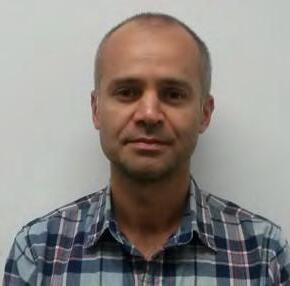
FROM: Perth, Western Australia
FIELD ROLE: Medical doctor, Martissant, Haiti, October 2015 to April 2016
The service in Martissant opened in 2006 but my role, dedicated to training staff and reorganising the service, was new. It’s a very busy service. On average we saw around 150 patients per day in the emergency department, cared for by two doctors and three nurses. In Martissant the rates for both physical and psychological trauma—direct and indirect— are particularly high, generating 60 per cent of our caseload.
In addition, between July and November, four cholera treatment centres were supported in the Oromia region, where 536 cases were treated.
Providing humanitarian aid in Ethiopia remains difficult. In 2016, Médecins Sans Frontières France decided to close its Ethiopian program. This decision was made because of the extreme difficulties of working in the country, due to administrative constraints and denial of access to areas affected by health or humanitarian problems. Other sections of the organisation maintain their support to the population.
The main issues were the ongoing violence between the armed groups in the capital, the political instability and the extreme poverty coupled with the destruction caused by the earthquake. Housing is typically cramped and dilapidated, especially after the earthquake in 2010. The district is also home to a number of internally displaced camps since the disaster and poor transport and roads. Not surprisingly we saw many victims of traffic accidents—an average of one in five of those we treated. The presence of armed gangs, who largely control the area, also contributes to our caseload. We were treating up to 100 gunshot victims a month.
I was impressed with the resilience and strength of our national Haitian staff, given the suffering and violence they face on a daily basis. They will be always in my thoughts.
Health needs are immense in Haiti, and access to medical care was further hampered in 2016 by repeated strikes in public hospitals. There is a shortage of nursing staff and resources in public facilities, and private clinics remain unaffordable for most. Haiti’s health system was weakened further after the damage caused by Hurricane Matthew, which struck in October 2016.
The precarious living conditions that many people endure creates an environment conducive to domestic
accidents including burns. In Drouillard hospital in the capital, Port-au-Prince, Médecins Sans Frontières runs a severe burns unit which has become the de facto national referral centre for burns patients. In 2016, 43 per cent of people treated there were under the age of five. A total of 801 patients were admitted to the unit and 630 underwent major surgery. The teams applied 4,071
wound dressings, and conducted 14,030 physiotherapy sessions and 1,773 mental health consultations. They are working on training staff in public hospitals in the treatment of burns and improving access to high-quality care for burns patients. Médecins Sans Frontières supported the response to Hurricane Matthew in the central and northern areas of the country. We donated medicines to health facilities, and helped reconstruct facilities that had been damaged by the hurricane.

KEY ACTIVITIES: Hepatitis C care, HIV/ AIDS care, maternal healthcare, mental healthcare, primary healthcare, tuberculosis care, vaccinations
Médecins Sans Frontières has run a project in south Tehran since 2012, providing medical care and psychological support to excluded and marginalised people.
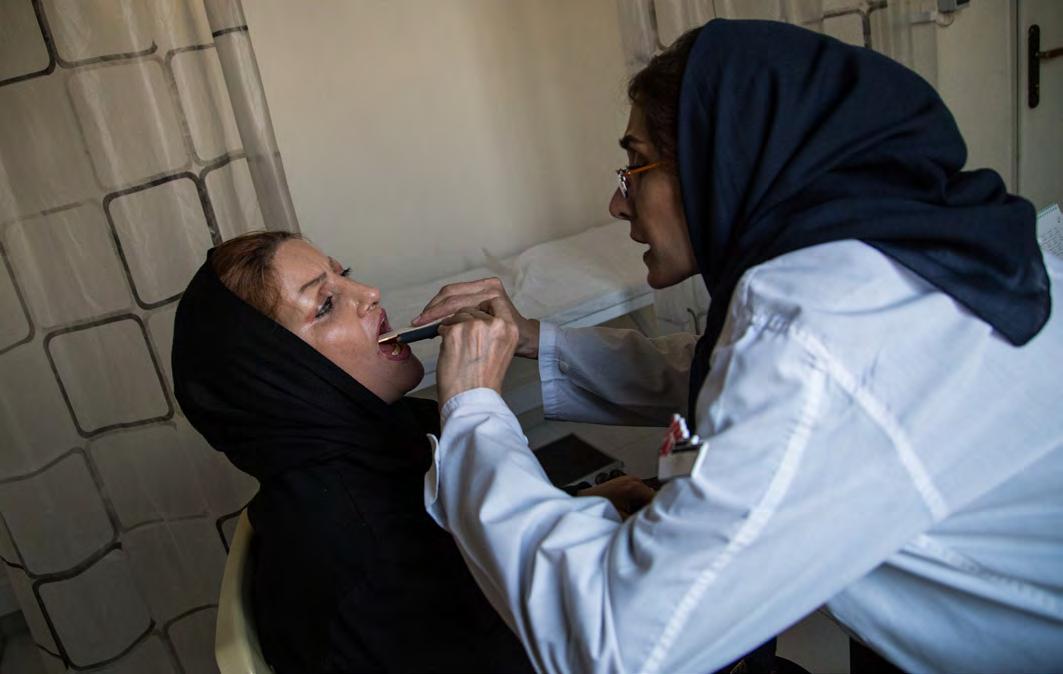
The Tehran project includes treatment for HIV, tuberculosis (TB) and hepatitis. This year, 15 hepatitis C patients were started on direct-acting antivirals, which are easier to administer than previous recommended treatments and have shorter course durations and higher cure rates.
In the district of Darvazeh Ghar, the provision of care for vulnerable populations is particularly limited. People with high-risk behaviours, such
as drug users, sex workers and street children, need specific services, as their living conditions and stigmatisation often prevent them from accessing regular health services.
Médecins Sans Frontières’ primary health centre provides comprehensive and integrated healthcare, including general medical consultations, mental healthcare, reproductive and sexual health services, testing for HIV, TB, hepatitis C and other infectious diseases,
FUNDING: $1,000,000
FIELD STAFF: 33
KEY MEDICAL FIGURE: 7,000 outpatient consultations
and vaccinations. Psychosocial support is also available, and peer workers play a key role in communicating with these hard-to-reach groups. Since April this year, our teams have also been running mobile clinics in partnership with a local NGO, Society for Recovery Support, which specialises in the field of addiction.
In 2016, the teams in the health centre conducted more than 7,000 outpatient consultations, and referred nearly 1,800 patients to secondary health facilities for further testing and/or admission. The mobile clinic carried out 2,326 consultations.
A primary health care consultation in Darvazeh Ghar. © Mahsa Ahrabi-Fard Médecins Sans Frontières Australia TEHRANKEY ACTIVITIES: Mental healthcare, primary healthcare, secondary healthcare, surgery
FIELD STAFF: 403
Years of armed conflict have disrupted health services in Iraq. Millions of people have been forced to flee their homes in search of safety in other parts of the country or across borders.
Since 2014, over 3.3 million people have been displaced across Iraq, and while many live in camps, others are living in schools, mosques and unfinished buildings. Throughout 2016, there was constant movement, with people fleeing from battle zones or returning to newly retaken areas.
In Abu Ghraib and Baghdad
numbers started to decline and the projects reoriented to become more responsive to population movements.
FUNDING: 1,875,000
KEY MEDICAL FIGURE: 34,000 consultations in Abu Ghraib
The offensive to retake Mosul, Iraq’s second biggest city, began in October 2016. Around 190,000 people were displaced from Mosul and the surrounding area in the last three months of the year.
In November, mobile teams were sent to new camps west of Erbil that were established to accommodate people fleeing the battle of Mosul. As well as general primary healthcare, they provided treatment for chronic diseases, and psychological and psychiatric care.
Iraq
Governorate, Médecins Sans Frontières provided primary healthcare, including treatment for mental health conditions and chronic non-communicable diseases, for the internally displaced and local population. In addition to mobile clinics, a primary healthcare centre was opened in Abu Ghraib in 2016 and more than 34,000 consultations were provided throughout the year. Mid-year, patient
In September in Al Anbar province, Médecins Sans Frontières opened a secondary healthcare centre in Amriyat Al Fallujah camp, which hosts around 60,000 Iraqis displaced by conflict in Fallujah and Ramadi. People in the camps are exposed to harsh climatic conditions, with temperatures reaching 50°C in summer. The centre offers general medical consultations, an emergency room and psychological support. More than 1,200 patients attended the centre in 2016, while 14,000 consultations were conducted by mobile teams in the area.
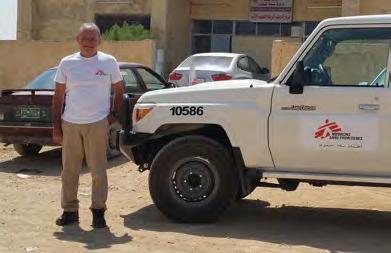
NAME: Graham Baker
FROM: Woodroffe, NT
FIELD ROLE:
Logistician, Iraq, April to October, 2016
In Dohuk I was supporting the maintenance of the maternity clinic of the refugee camp and looking after the Médecins Sans Frontières’ facilities office, guest houses and central warehouse. In the warehouse we had the Field Surgical Unit – a small emergency hospital set up in a series of tents – which has now been deployed near Mosul. In the Ninewa province, I was based in Zummar. Our programs included a mobile clinic that was going to three villages. The second part of my assignment was the renovation of the Tal Maraq maternity clinic. The first baby was born on the day when I left the country!
In Ninewa, my assistant had his house ransacked and destroyed by Islamic State. He lost all his possessions, and is now in the process of rebuilding. His family has lived there for
With no functioning secondary healthcare structure in Qayyarah, a town to the south of Mosul, Médecins Sans Frontières decided to set up a hospital with an emergency room, an operating theatre and a 32-bed inpatient department. The hospital opened in December and during the first month treated over 1,000 emergency patients and carried out more than 90 surgical interventions.
generations and chose not to leave. Although he had worked in the USA, he decided to come back to his community. For me that was a picture of the great resilience of these people.
© Graham Baker / MSFKEY ACTIVITIES: Maternal healthcare, mental healthcare, surgery
FIELD STAFF: 297
FUNDING: $4,100,000
KEY MEDICAL FIGURE: 3,663 deliveries supported in Irbid
More than 650,000 registered Syrian refugees live in Jordan. Their access to healthcare is extremely limited due to inadequate legal documentation, financial constraints and border closures.
Médecins Sans Frontières is the main reproductive healthcare provider for Syrian refugees in Irbid governorate. The maternity clinic was expanded in 2016, assisting with a total of 3,663 deliveries and 14,858 antenatal consultations across the year. The capacity of the newborn unit was also increased and 658 babies were admitted to the unit. The project also provides mental health support, mostly to children under the age of 18, including group and individual sessions.
Since 2013, Médecins Sans Frontières has supported medical facilities in southern
Syria from Jordan, including donating surgical and paediatric kits. In 2016 we began supporting a new hospital, including the emergency, surgery and maternity departments, as well as the blood bank. This support consists of donations as well as technical support and distance training.
The Amman reconstructive surgery hospital treats war-wounded patients and indirect victims of violence from war-torn neighbouring countries,
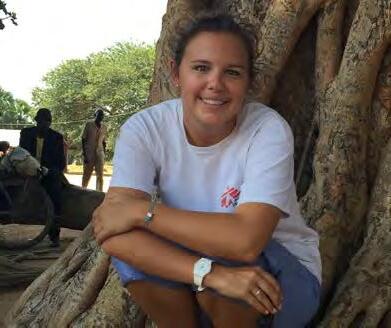
NAME: Nicole
CampbellFROM: Maroubra, NSW
FIELD ROLE:
Neonatal nurse, Irbid, Jordan, April to July
2016
When I first arrived in Jordan there was a baby diagnosed with neonatal diabetes mellitus, a rare form of diabetes. This baby was on continuous IV fluids, a gruelling insulin regime and countless procedures to maintain and monitor his blood glucose levels. The mother came back when the baby was three months old. She had a log book with all his blood glucose readings and could tell us her management for every event. It was impressive how well this little family was adapting and how happy they were, especially because this mother had previously lost two babies in the first 3-5 days of life. By providing advanced neonatal care to this newborn we saved its life and helped this mother complete her family. The greatest rewards were sending babies home to their families. Seeing mothers who have been so frightened and so unsure bonding with the nursing staff, sharing in our successes, supporting each other and smiling when the day comes that they can go home. The greatest challenge for
mostly Iraq, Yemen, Syria and Palestine. The hospital provides holistic care for patients requiring orthopaedic, reconstructive and maxillofacial surgery, including physiotherapy and mental health support. Since its opening in 2006, the hospital has treated nearly 4,500 patients and performed more than 10,000 surgical operations. In 2016, a total of 1,055 surgical procedures were performed, with patients staying an average of 138 days given the complexity of the procedures. In 2016, a new dental clinic was opened that specialises in the placement of dental implants.
me was being aware that there are thousands of Syrians in refugee camps and knowing that these women are having babies and need healthcare.
KEY ACTIVITIES: HIV/AIDS care, maternal healthcare, secondary healthcare, sexual violence care, tuberculosis care
FUNDING: $4,897,000
FIELD STAFF: 566
KEY MEDICAL FIGURE: 162,653 outpatient consultations in Dagahaley, Dadaab
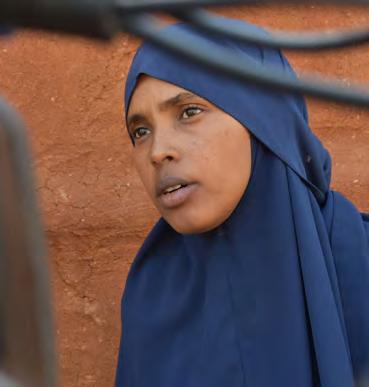
In 2016, Médecins Sans Frontières continued to offer care to marginalised people including refugees and those living in slums, as well as providing medical care to people with HIV.
In May, the Kenyan government announced they would close the Dadaab refugee camps in north-eastern Kenya by the end of the year, forcing refugees back to war-torn Somalia. Médecins Sans Frontières publicly opposed the decision, and in August carried out a survey in Dagahaley, one of the five camps that make up the complex, that showed 86 per cent of people were unwilling to return to Somalia. In November, the government announced it would extend the deadline for closure until May 2017.
Throughout the year, Médecins Sans Frontières continued its work in the 100bed hospital in Dagahaley, and at two health posts. Teams carried out 162,653 outpatient consultations, and admitted 9,137 patients to the hospital, including 917 children with severe malnutrition. More than 3,000 babies were born in the hospital’s maternity ward.
Since 2008, Médecins Sans Frontières’ clinic in Nairobi Eastlands has been providing psychological, medical, legal and social assistance to victims of sexual violence. From the end of 2015, our teams have also worked with authorities to develop an integrated model of care in two primary healthcare facilities in Eastlands. More than 2,700 new patients were treated in 2016, half of whom were minors.
Médecins Sans Frontières continues to work with local authorities to increase access to emergency care for people living in Mathare slum and the
Eastleigh neighbourhood. The project includes a call centre, an ambulance referral service and support to the emergency department of Mama Lucy Kibaki hospital comprising staff, triage, training and donations of equipment and drugs. Our ambulances responded more than 5,200 times during the year, and over 24,000 people were seen at the hospital’s emergency department.
A team in Eastlands also supports the detection and treatment of multidrugresistant TB (MDR-TB). In 2016, a total of 18 MDR-TB patients were diagnosed, and four began treatment regimens containing bedaquiline or delamanid, the first new TB drugs to be developed in 50 years.
Homa Bay
HIV remains a major health problem in the Nyanza region, including in Ndhiwa sub county, Homa Bay, where one in four adults are living with the virus. Since 2014, Médecins Sans Frontières has run a
Ayaan* was born in Dadaab.
“Living in Dadaab is both good and bad. You cannot leave to go anywhere, it is an open prison. But still, this is the only place I know, and the only place I can call home. It is where I grew up and was educated. I want to stay here because it is peaceful. I do not know what Somalia is.”
*Patient name has been changed
Mohamed Ali/MSFprogram in Ndhiwa aimed at controlling the spread of HIV, and reducing the number of deaths from the disease. Our teams work jointly with the Ministry of Health and local communities to strengthen all HIV prevention and care measures in the county, such as voluntary male circumcision, prevention of mother-to-child transmission, HIV testing and antiretroviral (ARV) therapy, and support with adherence and secondary care, including the treatment of opportunistic diseases.
Médecins Sans Frontières is also involved in the adult medical ward of Homa Bay and Ndhiwa hospitals to improve the quality of care provided for HIV and non-HIV patients. Our teams work on general organisation, staff recruitment, training, review of protocols and quality of clinical and nursing care. In 2016, more than 3,000 patients were diagnosed with HIV and enrolled in treatment, and more than 14,300 patients were receiving ARVs in Ndhiwa. Around 5,000 people were admitted to the Médecins Sans Frontières-supported Ndhiwa and Homa Bay hospitals’ adult inpatient wards.
KEY ACTIVITIES: Primary healthcare
FIELD STAFF: 88
In 2016, Médecins Sans Frontières launched a new project in the south-west of Kyrgyzstan focusing on the health effects of environmental pollution.
Médecins Sans Frontières has worked in Kyrgyzstan for many years to improve access to treatment for people with drug-resistant tuberculosis, a disease which is highly prevalent in this Central Asian country.
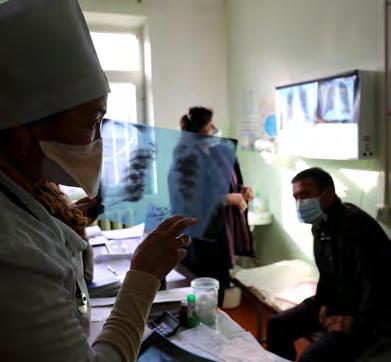
In 2016, we expanded the scope of our work, launching a project to address the
higher incidence of non-communicable diseases including anaemia and hypertension, potentially caused by environmental pollution from mining. The project launched in December 2016 in the south-western city of Aidarken in Batken district, which has mercury mines that have not been used since the collapse of the USSR. The project aims to support the Ministry of Health at primary
NAME: Marie Reyes
FROM: Sydney, NSW
FIELD ROLE: Nursing activity manager, Osh, Kyrgyzstan, January to July 2016
Our team works closely with the Ministry of Health to introduce an ambulatory model of care for drug-resistant TB (DR-TB) management. This model aims to limit the time patients spend in hospital, and improve their adherence to treatment. The project also has a community awareness arm. We hope that educating the public that TB can be cured if diagnosed early will reduce the stigma associated with the disease.
The current treatment for DR-TB is a long and arduous journey that can take two years or longer. The regimen includes injections for many months and about 20 tablets per day. There are also many terrible side effects including nausea and vomiting, diarrhoea and joint pain, rash and skin discolouration, depression, and hearing loss. Understandably, not all make it through the journey. Sadly, Dilya* is one of them. She is a young woman in her twenties that simply could not adhere to her treatment. She is now receiving palliative care and our team is providing oxygen at her home to make her laboured breathing more comfortable. Dilya is a tragic example of why we need to
FUNDING: $200,000
KEY MEDICAL FIGURE: Six primary healthcare centres supported
healthcare level to better diagnose and manage non-communicable diseases, as well as improve the management of mother and child healthcare. During the first month of operations we recruited staff and began supporting six local primary healthcare centres with medicine, medical items and training, with an objective of gaining a greater understanding of the health needs of this vulnerable population and developing effective strategies to improve their medical situation.
find a shorter and better treatment regimen for DRTB. But, to keep things in perspective, despite the inherent challenges with DRTB treatments, last month alone we had seven DRTB patients declared cured!
*Patient name has been changed
A doctor examines the x-ray of a TB patient in Osh. © Joosarang Lee/MSFLEBANON
SAIDA SYRIAKEY ACTIVITIES: Primary healthcare, sexual and reproductive healthcare
FIELD STAFF: 235
FUNDING: $200,000
KEY MEDICAL FIGURE: 3,044 sexual and reproductive healthcare consultations
More than 1.5 million Syrians have fled into Lebanon since the Syrian conflict began in 2011, making Lebanon and Jordan the countries hosting the largest proportion of refugees in the world.

This influx of Syrian refugees has further strained Lebanon’s economy and infrastructure and this is particularly felt in the health sector. Despite the efforts of the Ministry of Health and UNHCR, access to medical services has become increasingly difficult, if not impossible, for vulnerable people such as Lebanese returnees, Palestinian and Syrian refugees, as well as host communities.
Since June 2013, Médecins Sans Frontières has provided primary healthcare consultations at the Human Call Hospital
in Ein-el-Hilweh camp. The camp hosts around 100,000 people, including Syrian refugees and Palestinian refugees from Syria. The primary healthcare centre provides consultations on sexualreproductive health, including antenatal care, postnatal care and family planning, as well as general acute health consultations and psychosocial support. In 2016 teams at the health centre provided 16,860 consultations, including 3,044 sexualreproductive health consultations.
In 2016 teams at the health centre provided 16,860 consultations, including 3,044 sexualreproductive health consultations.
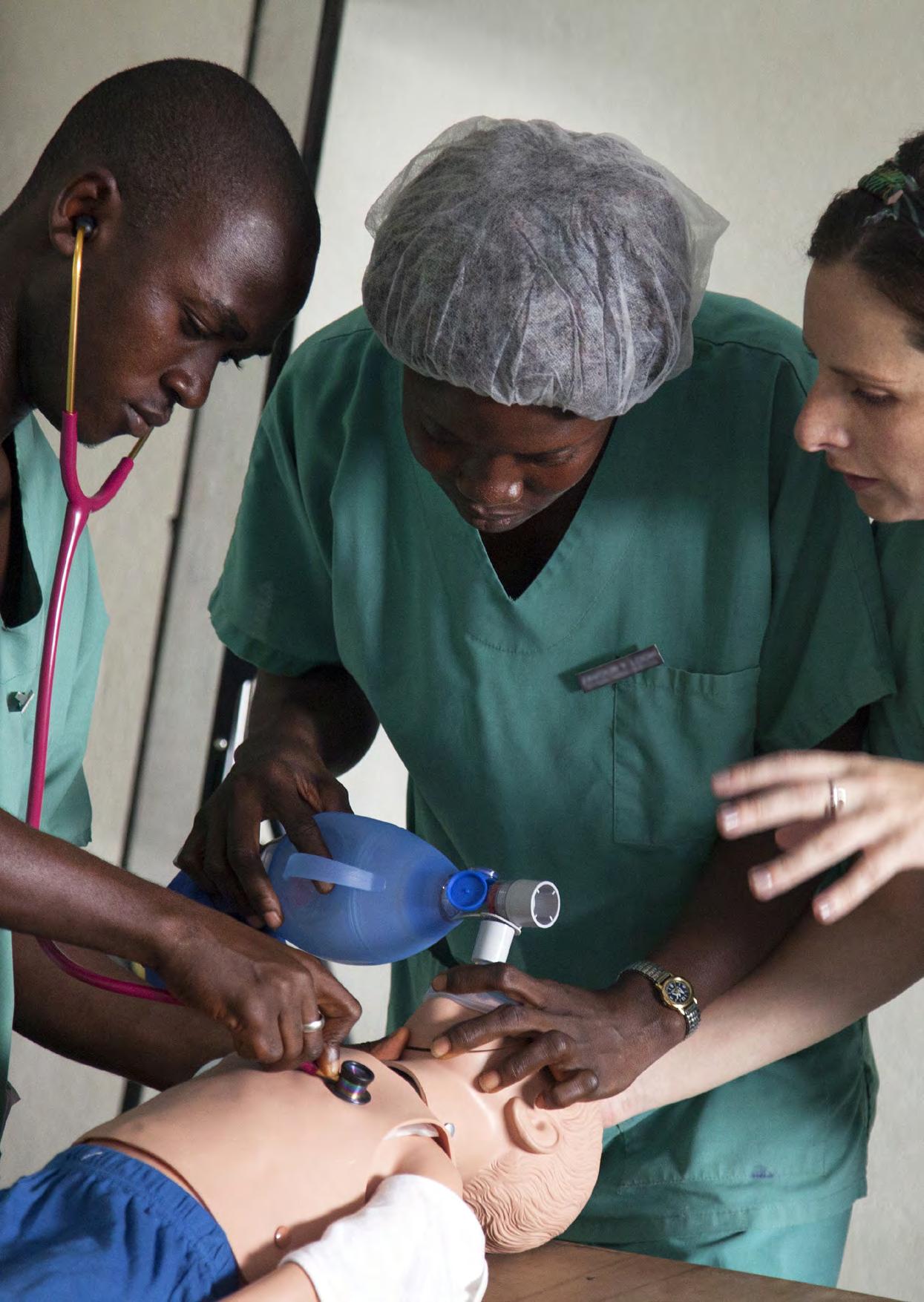
LIBERIA
KEY ACTIVITIES: Newborn care, nutrition care, paediatric care, post-Ebola care
FUNDING: $800,000
FIELD STAFF: 324 KEY MEDICAL FIGURE: 600 Ebola survivors received medical assistance
The West African Ebola outbreak of 2014–2015 took a severe toll on the already fragile Liberian health system.
Over 4,800 people died during the outbreak in Liberia, including 184 healthcare professionals. Although health services are progressively being restored, significant gaps persist, including in specialised paediatric care and mental healthcare.
In 2015, the Bardnesville Junction Hospital was established in Monrovia, the Liberian capital. The hospital provides specialised and emergency paediatric care, newborn care and management of complicated severe malnutrition. A clinic for Ebola survivors offers medical assistance,
including mental healthcare. Strict attention has been given to infection prevention and control measures to enable the continuity of healthcare in any potential Ebola outbreak.
In September 2016, the Liberia Board of Nursery and Midwifery validated Médecins Sans Frontières’ hospital as a site for clinical skills training. The first group of nursing students completed their practical training in December.
During 2016, a total of 8,200 emergency consultations were carried out and nearly 4,500 patients were admitted to
NAME: Loren Shirley
FROM: Tasmania
FIELD ROLE: Country Pharmacist, Monrovia, Liberia, November 2015 to March 2016
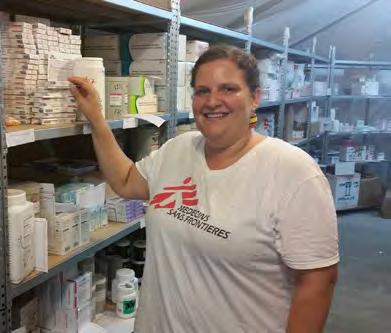
As the country pharmacist in Liberia, my overall responsibility was to ensure that Médecins Sans Frontières’ projects had the medications they needed and that these medications were safe, effective and used in the right way. Liberia was at the tail end of the Ebola outbreak during my assignment but survivors continued to face physical and mental health challenges, so Médecins Sans Frontières was running a survivor clinic, as well as a paediatric hospital. An important part of my role was liaising with authorities and other non-government organisations to ensure our importation of medications ran smoothly. I also worked closely with my Liberian pharmacist colleague, teaching her how to review drug charts, as well as with our nurses and doctors to improve quality of care.
the hospital. The Ebola survivor clinic provided care to approximately 600 patients, conducting an average of 240 consultations each month. In December Médecins Sans Frontières was able to transfer patients from the survivor clinic to three Ministry of Health centres in Monrovia and the clinic was closed.
Left: Student nurses receive training in paediatric resuscitation © Marco GarofaloA clinic for Ebola survivors offers medical assistance, including mental healthcare.
KEY ACTIVITIES: Emergency healthcare, maternal healthcare, paediatrics
FIELD STAFF: 24
The breakdown of law and order, economic collapse and political instability have had a severe impact on the healthcare system. It remains extremely challenging for Médecins Sans Frontières to operate in Libya given the precarious security situation.
In 2016 Médecins Sans Frontières supported the main Misrata hospital, aiming to increase emergency management capacity and provide assistance to internally displaced people. Teams treated 360 injured people and 40 hepatitis C patients. However, the project was closed at the end of August due to the difficulty of access.
Médecins Sans Frontières maintains a
national staff base in Misrata to initiate exploratory assessments, monitor migratory issues and train staff in infection control and prevention.
Benghazi
Only three out of twelve hospitals in Benghazi remain functional. We opened a health facility in Al-Abyar providing emergency care, antenatal care and vaccinations, before its closure in August 2016. In partnership with a local NGO, our teams distributed food for 2,100 families and set up a mother and child health clinic which provided 3,000 paediatric consultations and 800 obstetrics-gynaecology consultations across the year. Support is also provided
NAME: Colin Watson
FROM: Alice Springs, NT
FIELD ROLE: Nursing Supervisor, Al Abyar, Libya, December 2015 to February 2016
The project in Al Abyar supports the local hospital, specifically upgrading the emergency room facilities and providing training. The emergency room saw a constant stream of patients throughout the day presenting with a range of conditions from minor ailments to major trauma. A particular focus of my work was training the nurses in triage and trauma management. Despite the obvious issues of language, I was able to forge good working relationships with my Libyan colleagues and put in place the foundations for safe and reliable emergency care. But with no end in sight to the conflict in Libya, the health care needs will remain for the immediate future.
I worked with a doctor from Benghazi who spoke of the tragic consequences of not having access to essential medicines. ‘What should I do?’ he asked me. ‘I know my patient will die without medicine but all I have to give him are the tears in my eyes,’ he said. Over the past six months,

FUNDING: $2,000,000
KEY MEDICAL FIGURE: More than 3,100 deliveries assisted in Al Marj
to the emergency department of the Benghazi Medical Centre hospital. Al-Marj Hospital, a 30-minute drive from Al-Abyar, is the main reference hospital for complicated obstetric cases. Médecins Sans Frontières has supported this hospital with donations since April 2015, and in 2016 started to manage the maternity unit and provide direct patient care. Our medical team assisted more than 1,900 normal deliveries in 2016, and performed 1,200 caesarean sections.
In Zouara Jedi Ibrahim, Médecins Sans Frontières offered care to migrants and the host population, providing paediatric care and support to an emergency department which received 747 patients in the year. The project closed at the end of 2016.
Médecins Sans Frontières has been able to support a number of hospitals across Libya, often in very challenging contexts. Our ongoing activities in Libya will undoubtedly help to alleviate health care needs and ensure that medical staff have both the skills and resources to treat their patients.
MALAWI
CHIRADZULU
HIV/AIDS remains a major public health concern in Malawi, where an estimated 980,000 people have the virus.
Malawi has a huge budget deficit, leaving the health system struggling. Despite this bleak situation, the country’s ambitious HIV program has achieved significant success. HIV prevalence has steadily declined – from 16.4 per cent among 15-to-49-year-olds in 1999 to 10.6 per cent in 2014, according to a national study.
For 18 years, Médecins Sans Frontières has worked in partnership with the Ministry of Health to support HIV patients in Chiradzulu district. This remarkable collaboration has helped decentralise care to local services, simplify care protocols and delegate treatment to lower-level medical staff – all measures to ensure that treatment is as accessible as possible.
A four-year handover process is underway to ensure high-quality management of stable HIV patients once our teams withdraw from the project. Médecins Sans Frontières now focuses on hardto-reach groups, including adolescents with HIV and patients whose treatment has failed and need second- or third-line antiretrovirals. The team is also improving access to viral load testing in five district health centres and providing screening and preventive treatment for cervical cancer. A total of 31,924 people with HIV were receiving antiretrovirals by the end of 2016.
After a major cholera outbreak on Lake Chilwa in early 2016, we launched a mass vaccination campaign, which reached 108,400 people. An innovative two-dose strategy was used for 5,863 hard-to-reach fishermen, with the second dose being self-administered two weeks after the first.
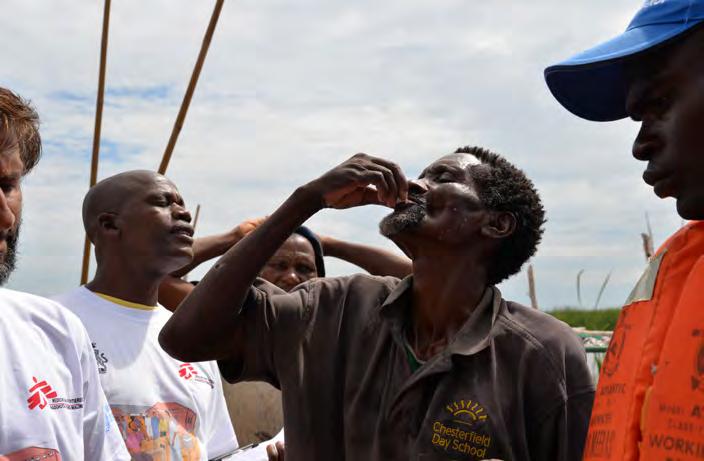
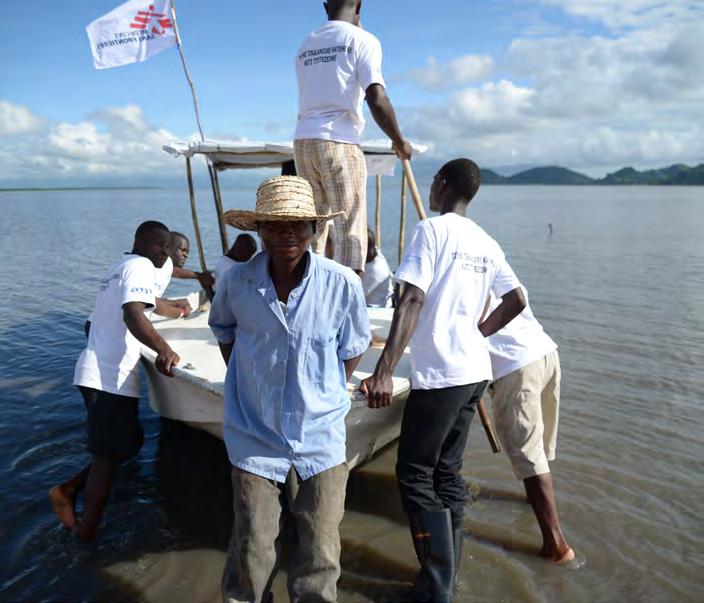
KEY ACTIVITIES: HIV/AIDS, response to outbreaks
FUNDING: $600,000
FIELD STAFF: 182 KEY MEDICAL FIGURE: 108,000 people vaccinated against cholera
Project locations funded by Australian donors
A boat departs for the vaccination campaign, Lake Chilwa. © Aurelie Baumel/MSFKEY ACTIVITIES: Malaria care, nutrition care, paediatrics, primary healthcare
FIELD STAFF: 544
In 2016 Médecins Sans Frontières continued to run a long-standing paediatric program in southern Mali.
In Koutiala district, southern Mali, Médecins Sans Frontières has run a comprehensive paediatric program since 2009, aimed at reducing the morbidity and mortality of children under the age of five. In 2016, 7,032 children were admitted to the paediatric ward and 3,829 to the nutrition ward of the Médecins Sans Frontières-supported regional referral hospital in Koutiala. Teams also supported paediatric and nutrition activities in five health centres across the district, carrying out 90,203 outpatient consultations and treating 3,779 children for malnutrition. In these five health zones, a preventative “package” of health measures is implemented for all children under the age of two, including routine follow-up consultations, distribution of mosquito nets and supplementary foods, and vaccinations. This year, a total of 7,723 children benefited from the package.

Our teams also provide seasonal malaria chemoprophylaxis to children in Koutiala, with an average of 171,000 children receiving antimalarial drugs in each round in 2016. The process of handing over the SMC activities to the Ministry of Health began during the year.
The security situation in northern Mali remains unstable despite a peace agreement. In Timbuktu, unrest that began with a coup in 2012 resulted in thousands of people fleeing the region, including some medical staff. As people began to return to the city towards the end of 2016, Médecins Sans Frontières initiated a progressive handover of all its activities in the regional referral hospital to the Ministry of Health.
In December 2016 a new project was launched in Ténénkou, in the centre of
FUNDING: $2,400,000
KEY MEDICAL FIGURE: 171,000 children received seasonal malaria chemoprophylaxis
the country, where maternal mortality is particularly high. We opened an outpatient clinic and began supporting the Ténénkou referral health centre for women and adolescent girls.
Children receive treatment for acute malnutrition in Koutiala, Mali, July 2016. © Hadja Nantenin Dioumessy/MSFTeams also supported paediatric and nutrition activities in five health centres across the district, carrying out 90,203 outpatient consultations and treating 3,779 children for malnutrition.Médecins Sans Frontières Australia
MOZAMBIQUE
MAPUTO SOUTH AFRICAKEY ACTIVITIES: HIV/ AIDS, mental healthcare
FUNDING: $800,000
FIELD STAFF: 171 KEY MEDICAL FIGURE: 2,300 people received specialised HIV care
Despite efforts to halt the spread of HIV/AIDS, Mozambique remains one of the countries with the highest rates of infection, with an estimated adult prevalence of 11.5 per cent.
The country also has one of the highest rates of HIV and tuberculosis (TB) coinfection in the world, resulting in an increase in cases of multidrug-resistant TB (MDR-TB).
Since 2001, Médecins Sans Frontières has been supporting the Ministry of Health to ensure access to comprehensive healthcare for HIV and TB patients. Teams operate in six health centres and one referral facility in the capital Maputo. In 2016, activities focused on complicated HIV cases, including patients for whom treatment with antiretroviral drugs has failed or
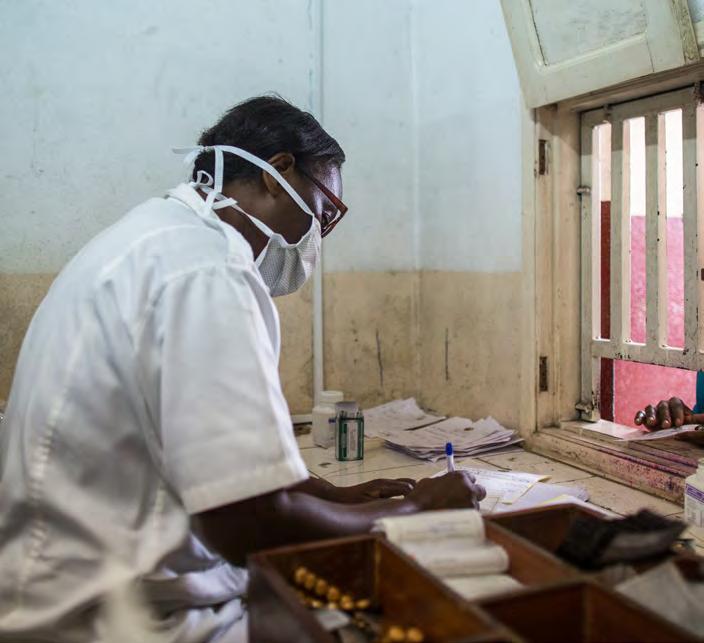
who have developed co-morbidities, such as MDR-TB, Kaposi’s sarcoma and other cancers, viral hepatitis or other opportunistic infections. During the year, more than 2,300 patients, including 160 children, received specialised HIV care. Teams monitored HIV patients’ viral load to ensure treatment was working effectively, as part of the strategy to improve quality of care.
Médecins Sans Frontières also supported the Ministry of Health in a dedicated MDR-TB program in which more than 170 patients received treatment this year, and
succeeded in registering new TB drugs in the country. A new program focusing on treatment for viral hepatitis C also began in 2016, with three patients starting treatment in the national health system.
In early 2016, our team started mental health activities for people with HIV and TB, with the support of the Ministry of Health. Overall, around 400 consultations were carried out, and many patients were diagnosed with depression. Most patients started psychotherapy, and some were treated with medication. The more difficult cases were regularly discussed by a multidisciplinary team, including social workers, psychologists and doctors.
A pharmacy in Mozambique. © Morgana Wingard/NAMUHDuring the year, more than 2,300 patients, including 160 children, received specialised HIV care.ZAMBIA ZIMBABWE BOTSWANA Project locations funded by Australian donors
KEY ACTIVITIES: Maternal healthcare, primary healthcare
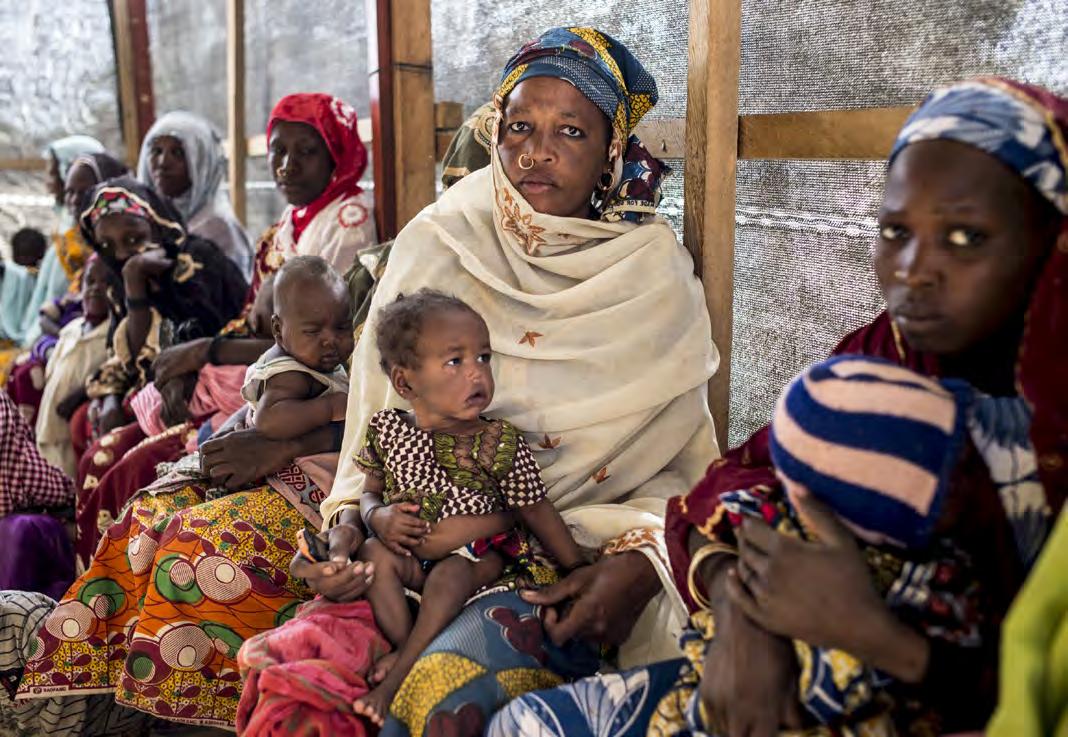
FIELD STAFF: 146
The people of Myanmar are still suffering the consequences of decades of authoritarianism, and access to medical treatment remains limited, particularly for marginalised communities and certain ethnic groups.
In Wa Special Region 2, in the eastern part of the country, the provision of healthcare is extremely limited with almost no accessible primary or secondary healthcare. Due to a worsening political situation and an inability to secure access to the region
for international staff, Médecins Sans Frontières’ medical activities were restricted in 2016. We emphasised training local staff to build skills in the absence of international staff. In the remote Pang Yang and Lin Haw townships, our teams conducted
FUNDING: $200,000
KEY MEDICAL FIGURE: 9,000 outpatient consultations provided
over 9,000 outpatient consultations through fixed and mobile clinics. Reproductive healthcare is also scarce in the region, and our teams provided 207 antenatal consultations in the year. We also supported Ministry of Health vaccination campaigns, especially in terms of logistics and to follow up any medical complications. In October, we conducted a health promotion and community needs assessment in order to begin some health promotion activities.
KEY ACTIVITIES: Malaria care, nutrition care, paediatrics, primary healthcare
FIELD STAFF: 1,025
In Niger, Médecins Sans Frontières focuses on reducing child mortality, particularly during the annual nutrition and malaria crisis.
Diffa region, on the border with Nigeria, continued to suffer the consequences of the conflict between Boko Haram and the different armies in the area.
Médecins Sans Frontières started working in Diffa in June 2015 to provide access to primary healthcare. According to local authorities, at the end of 2016, there were over 240,000 refugees and internally displaced people in Diffa, as well as 100,000 local residents living in precarious conditions, at risk of violence
Sarah*, fled northern Nigeria when her village was attacked and found refuge in Diffa region.
“I took my son to the health centre today because he is malnourished. I have just visited so that he can receive his treatment, a therapeutic food. This health centre is wonderful because when we come with our children or when we are ill ourselves, we are looked after for free. When Boko Haram attacked, we left Malanfatori in a rush and in a total panic. Some of our children succeeded in fleeing with us, but others were left behind and some women lost their husbands during the escape. They pursued us until we succeeded in crossing the Komadougou river to come to Niger. We arrived empty-handed and our husbands are not working. It is difficult to find food and it is very difficult to live in these conditions. Sometimes the state gives us help, and that is a relief.”
*Patient name has been changed
and disease. Many of these people were depending entirely on humanitarian aid to survive, yet the international community’s emergency response was not sufficient to fulfil their basic needs. Médecins Sans Frontières published a report highlighting this emergency gap to mobilise the international community. Throughout 2016, our teams worked in seven health centres in the area, providing 77,570 consultations.
FUNDING: $3,700,000
KEY MEDICAL FIGURE: 117,000 children provided with seasonal malaria chemoprevention
the hospital referral system for the most severe cases. More than 13,300 children were admitted to hospital in Magaria –over 50 per cent of whom were suffering from severe acute malnutrition – and more than 66,500 children were treated in rural areas.
Our teams also ran communitybased activities to combat malaria, including providing seasonal malaria chemoprevention – the repeated administration of antimalarials as a prophylactic – for more than 117,000 children in eight health zones in Magaria district.
Every year, the levels of childhood mortality and morbidity increase during the peak malnutrition and malaria season in Magaria health district, and in the rest of Niger. In 2016, Médecins Sans Frontières continued to support the Magaria district hospital through the paediatric unit and an intensive therapeutic feeding centre, which had 600 beds at the peak of the season. In addition, our teams supported 11 health centres by providing primary healthcare to children under five, and reinforced
With a population of 500,000, Madarounfa is one the largest districts in Maradi region. Médecins Sans Frontières continues to run its paediatric program focusing on the management of the main causes of child death, notably malnutrition and malaria, in Madarounfa town and the surrounding area. Mothers also come over the border from Nigeria to seek treatment for their children. The program, which opened in 2001, today comprises inpatient care for severe acute malnutrition and other diseases, and outpatient treatment for severe malnutrition without complications. This year, the team began providing neonatal care, and worked to improve community-based treatment of malaria. A total of 12,256 children received outpatient care for severe malnutrition, 3,317 were treated in the inpatient therapeutic feeding centre and 5,334 were admitted for other diseases.
Médecins Sans Frontières started working in Diffa in June 2015 to provide access to primary healthcare.ALGERIA CHAD MAGARIA ZINDER MARADI MADAROUNFA DIFFA MALI NIGER Project locations funded by Australian donors
NIGERIA
KEY ACTIVITIES: Nutrition care, maternal healthcare, paediatrics, sexual violence care, vaccinations
FIELD STAFF: 717
FUNDING: $4,900,000
KEY MEDICAL FIGURE: More than 10,500 children treated for malnutrition
The conflict between Boko Haram and the Nigerian military, which began in 2009, has displaced an estimated 1.8 million people across the northeast of the country.
In 2016, the conflict resulted in a catastrophic humanitarian emergency in several areas of Borno state, with high mortality rates linked to severe malnutrition and preventable diseases.
Médecins Sans Frontières scaled up its emergency assistance in Borno state, to reduce the risk of death and disease among communities living in dire conditions. Insecurity restricted our presence, and in some of the hardest hit areas teams could only carry out short visits with rapid interventions aiming to have the most impact in a short time frame.
In Maiduguri, the state capital, we focus on maternal and child health, running an inpatient therapeutic feeding centre in Gwange district and two large health centres in Maimusari and Bolori. In May 2016, we increased the capacity of the Gwange health facility from 30 to 120 beds. In Maimusari, teams set up a paediatric emergency room and inpatient facility. A mobile team runs food distribution and offers medical and nutritional care and vaccination in four informal camps. More than 10,500 children were admitted to outpatient feeding programs, and 1,740 were admitted as inpatients. There were more than 201,000 outpatient consultations in Maiduguri.
In 2016, Médecins Sans Frontières gained access to the hard-to-reach localities of Bama, Monguno and Dikwa. In Monguno, there was virtually no healthcare available for the local
population. In September 2016 we opened an inpatient therapeutic feeding centre and a paediatric department with a capacity of 50 beds. More than 650 children were admitted to the paediatric department and 230 to the feeding centre by the end of 2016.
During visits to Bama in June 2016, our teams found people in a catastrophic situation, with 19 per cent of children suffering severe acute malnutrition. Further north, in Dikwa, rates of malnutrition were also high, and the town mostly destroyed. Médecins Sans Frontières set up a mass intervention package aiming to reduce mortality and morbidity as quickly as possible,
including food distribution, vaccinations and seasonal malaria chemoprophylaxis.
Following an awareness campaign delivered through schools, health clinics, police stations and the media, monthly attendance at Médecins Sans Frontières’ program for victims of sexual violence in Port Harcourt, Rivers State, increased from 35 patients to 70. The comprehensive healthcare package includes prophylaxis for HIV and sexually transmitted infections, vaccinations for tetanus and hepatitis B, emergency contraception, and counselling and psychosocial support for victims of rape and sexual abuse.
Jigawa State has one of the highest maternal mortality rates among Nigerian states, with 2,000 deaths per 100,000 live births. Médecins Sans Frontières continued to run its vesico-vaginal fistula and emergency obstetric program in Jahun general hospital. This year, 70 per cent of the 10,500 women admitted to the maternity unit had complicated pregnancies and deliveries. The team performed 2,660 obstetrics-related surgical procedures, treated 400 women with fistulas, and assisted 7,365 births. A total of 1,293 babies and 1,141 women were admitted for intensive care. Médecins Sans Frontières also donated 8,228 units of blood to the hospital. In order to bring antenatal and obstetric care closer to patients and identify and avoid pregnancy complications, basic emergency obstetric services were set up in the nearby Aujara and Miga health centres in September.
More than 10,500 children were admitted to outpatient feeding programs, and 1,740 were admitted as inpatients. There were more than 201,000 outpatient consultations in Maiduguri.
PAKISTAN
KEY ACTIVITIES: Maternal healthcare, paediatrics
FUNDING: $2,000,000
FIELD STAFF: 295 KEY MEDICAL FIGURE: 4,906 deliveries assisted in Peshawar
Access to healthcare remains a challenge in Pakistan, especially for people in isolated rural communities, urban slums and areas affected by conflict.
Healthcare for women and children is a serious concern: women in rural areas die from preventable complications during pregnancy and delivery, and neonatal care is unavailable in many areas. According to the Pakistan Democratic and Health Survey, one in every 11 children dies before the age of five.
At the Women’s Hospital in Peshawar, Médecins Sans Frontières offers comprehensive 24-hour emergency obstetric care for patients referred from surrounding districts and the Federally
Administered Tribal Areas (FATA). The hospital has 24 obstetric beds and an 18bed newborn unit for specialised care for premature and severely ill neonates. In January, the new outreach team started working to improve liaison between patients, hospital and the community. In 2016, a total of 4,906 deliveries were assisted, including 479 caesarean sections. Our teams also introduced the Continuous Positive Airway Pressure technique for newborns suffering from severe asphyxia [loss of oxygen] at birth. A study of antibiotic resistance in neonatal septicaemia is also underway.
NAME: Shelagh Woods
FROM: Adelaide, SA
FIELD ROLE: Head of Mission, Pakistan, October 2013 to April 2016

Pakistan is a lower middle income country but in terms of health indicators, it’s comparable with much poorer countries. There is a lot of inequity. The biggest needs are especially in the areas where there has been conflict, along the border of Baluchistan, Khyber Pakhtunkhwa and FATA, the Federally Administrated Tribal Areas, and for other reasons, in Karachi. As Head of Mission, you are like the glue that holds everything together and keeps everyone moving in the same direction. If you have good people in your teams, then your job is ensuring good communication and collaboration, sorting out legal issues, representation and other high-level activities and strategic issues. A great part of the job is that you do get to move around—as do all the coordination team—especially when you’re doing assessments and exploratory missions. You can enjoy spending time with the teams in the field, and then it’s also nice to be back in the capital. No week was the same. There
The security situation is tense in several provinces in Pakistan, including in the FATA. At Sadda Tehsil headquarters hospital in Kurram Agency, Médecins Sans Frontières provides outpatient care for children up to 5 years; inpatient care for children under 12 years; treatment for cutaneous leishmaniasis [a parasitic skin infection]; antenatal care and obstetric and emergency referrals; and supports the Ministry of Health in emergencies. In 2016, staff carried out an average of 3,000 outpatient consultations per month. At the smaller Alizai hospital, teams conducted an average of 120 paediatric outpatient consultations each week.
was not one day, or one minute of a day, when I was sitting there going ‘what am I going to do next?’. It was challenge after challenge.
KEY ACTIVITIES: Burns care, mental healthcare
FUNDING: $1,500,000
FIELD STAFF: 113 KEY MEDICAL FIGURE: 35,500 children reached by burns awareness campaign
In 2016, Médecins Sans Frontières continued its long-running mental health programs on the West Bank and support to victims of burns and trauma in the Gaza Strip.
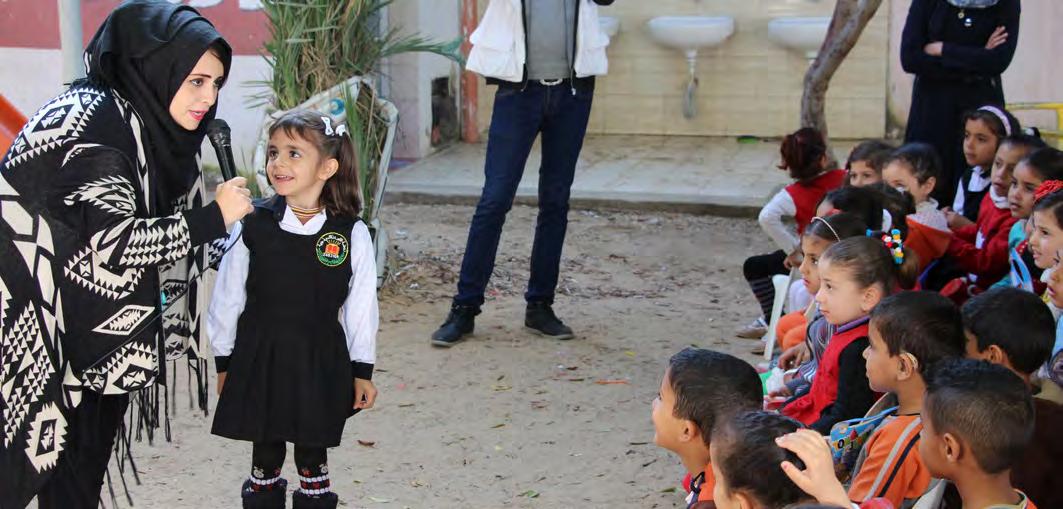
The situation of ongoing conflict in Palestine, coupled with a deterioration in social and economic conditions, creates many risk factors for distress and mental disorders.
Médecins Sans Frontières supports programs in Nablus and Qalqilya providing psychological and social assistance to people with moderate or severe mental health conditions. In 2016, we started a partnership with An-Najah University in Nablus to launch the first Master’s degree in clinical psychology in Palestine. A mental health consultation room was also opened in Qalqilya, a town east of Nablus.
Our teams supported the burns unit of Rafidya hospital in Nablus, focusing on moderate to severe cases through a
multidisciplinary approach including psychological, medical and social interventions.
In the Gaza Strip many homes have been destroyed or damaged by conflict, putting people at risk of domestic accidents including burns. Médecins Sans Frontières’ burns and trauma centres in the Gaza Strip treated over 4,231 patients, mostly children. Staff dressed more than 52,000 wounds, and conducted over 36,000 physiotherapy and 1,000 occupational therapy sessions, mostly for patients with burns. There are three centres, in Gaza City, Khan Younis and Bet Lahyia, the last of which opened in July this year. In 2016, we launched a burns awareness campaign that reached more than 35,500 children in schools, kindergartens and nurseries.
The surgical programs that Médecins Sans Frontières runs in Al Shifa and Nasser hospitals in conjunction with the Health Ministry provided a total of 275 surgical interventions, 71 per cent of them on children under 16 years of age. Complex cases that cannot be handled in Gaza are referred to our reconstructive surgery hospital in Jordan (see page 30). However, due to administrative delays, only nine out of 77 patients were successfully referred in 2016.
Médecins Sans Frontières’ burns and trauma centres in the Gaza Strip treated over 4,231 patients, mostly children.Children take part in a burns awareness campaign in Gaza, April 2016. © Paul Maakad/MSF Médecins Sans Frontières Australia QALQILYA NABLUS GAZA STRIP AMMAN PALESTINE Project locations funded by Australian donors
PORT MORESBY
KEY ACTIVITIES: Tuberculosis care
FIELD STAFF: 113
Project locations funded by Australian donors
Médecins Sans Frontières is working to improve access to screening and treatment for tuberculosis (TB) in Papua New Guinea.
Around 25 per cent of people with TB in Papua New Guinea live in Port Moresby, in the National Capital District.
In collaboration with the national TB program, Médecins Sans Frontières has been scaling up capacity for screening, diagnosis, treatment initiation and follow-up in Port Moresby’s Gerehu hospital. Mobile teams have also started working in the community to improve
patient adherence to treatment. The next step, in line with the national TB control strategy, is to support diagnostic and treatment activities through health centres, as well as develop outpatient care for patients with drug-resistant TB.
In Gulf province, to the west of Port Moresby, Médecins Sans Frontières expanded our TB program to support two health centres as well as Kerema general
NAME: Petra Van Beek
FROM: Burnett Heads, Queensland
FIELD ROLE: Field Administrator, Kerema, Papua New Guinea, March to October 2016
Ever since my university years I’ve wanted to work with Médecins Sans Frontières. Fast forward 33 years to March 2016 and there I stood at my local airport, about to fulfil this lifelong dream. I was heading to Papua New Guinea for six months as a Field Administrator, providing the human resources and finance support for a tuberculosis (TB) project in Kerema, a small remote coastal town 300km north-west of Port Moresby.
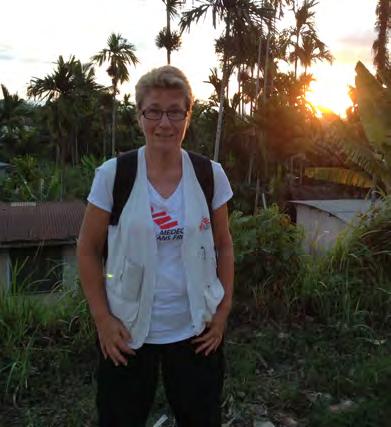
My role involved a combination of working with people and computers, and varied daily even within a distinct monthly cycle of payroll and finance month closure. Hiring locals, dealing with HR issues, and inducting international staff was mixed in with paying invoices, processing overtime / sick leave forms and managing contracts. Our team consisted of eight international staff from around the world and close to 50 local staff, working six days a week to treat hundreds of people with TB in an 18-bed TB hospital and two outreach medical centres. The project was two years into its forecasted eight to ten-year term and already we had cured patients, helping us locate and treat more patients and educate families and villages further and further afield. The work
FUNDING: $1,200,000
KEY MEDICAL FIGURE: More than 1,800 people receiving TB treatment
hospital. Currently, poor access to remote areas and the lack of an effective followup system result in a high number of patients not completing their treatment. In collaboration with provincial authorities, our teams continue to develop a decentralised model of care so that people do not need to come to a medical facility so frequently. By the end of 2016, Médecins Sans Frontières had initiated treatment for 1,819 patients with drugsensitive TB and 24 with drug-resistant TB. Nearly 30 per cent of patients are under 15 years of age.
Médecins Sans Frontières is doing there is first class – we are leading the way and setting the standards. It was a privilege to be part of it.
KEY ACTIVITIES: Nutrition care, malaria care, maternal healthcare, paediatrics, primary healthcare, secondary healthcare, vaccinations
South Sudan is still struggling to recover from the war of independence that led to its creation in 2011.
Not only is it the youngest country in the world, but also one of the least developed, and is repeatedly beset by crises. Intense fighting continues across the country, causing huge numbers of people to flee: 1.8 million had been displaced by the end of 2016. Three-quarters of the population do not have access to basic medical care and 80 per cent of health facilities are run by non-governmental organisations. After fighting broke out in the capital, Juba, in July, Médecins Sans Frontières set up a surgical facility, conducting 321 surgical procedures for the wounded.
In Yida, in the north of the country near the border with Sudan, Médecins Sans Frontières offers a broad range of inpatient and outpatient services to refugees from South Kordofan, Sudan, including vaccinations, and HIV and TB treatment. In March 2016, we resumed activities in southern Kordofan, in the Nuba Mountains, after the hospital was hit by airstrikes in 2014 and 2015. A team of international and national staff provided 67,307 primary care consultations and 39,158 vaccinations in 2016.
Bahr El Ghazal region
Médecins Sans Frontières manages paediatrics and maternal healthcare at Aweil hospital, the only secondary healthcare facility in the area, which serves 1.5 million people. The capacity of the hospital varies according to the season, from 165 beds to more than 300 beds during the malaria and malnutrition peak. The 2016
seasonal malaria peak was particularly severe, with more than 7,700 children hospitalised for severe malaria. A total of 2,462 children were admitted for severe acute malnutrition, which was also a large increase on 2015. Maternity activity is also constantly increasing, with a total of 5,843 deliveries in 2016, including 148 by caesarean section.
FUNDING: $6,600,000
FIELD STAFF: 1,480
KEY MEDICAL FIGURE: 7,700 children hospitalised for malaria in Aweil
were provided and 1,800 patients were admitted to the hospital. Cases of kala azar (leishmaniasis) – a potentially fatal disease transmitted by sandflies –increased three-fold in 2016 compared to 2015, with a total of 151 patients treated. This year we began the process of handing over activities in Old Fangak, to start activities in New Fangak, where only a few other humanitarian organisations are present.
Further south, in Wau, our team launched an emergency project in response to clashes between armed groups that displaced more than 40,000 people. Our mobile clinics, supporting four health centres in the area, carried out more than 42,000 consultations in July-August.
Médecins Sans Frontières runs a 40-bed hospital and an outpatient clinic in Old Fangak. In 2016, a total of 66,000 outpatient consultations
Médecins Sans Frontières has been working in Agok since 2008, and this year continued to focus on improving the quality of secondary healthcare, with a total of 7,662 patients admitted to Agok hospital. Our teams supported emergency surgery, obstetric care, management of malnutrition and treatment of HIV, tuberculosis (TB) and snakebites. An around-the-clock obstetric unit is now available, and 1,630 deliveries, including more than 90 caesarean sections, were assisted in 2016. Mobile teams treated 40,115 patients with simple malaria in villages around Agok. The epidemiological surveillance system we developed enabled teams to respond to two measles outbreaks, with 430 cases detected, isolated and treated.
Our project in Mayom provides primary healthcare, basic emergency treatment and stabilisation before referral to Agok hospital if necessary. In 2016, staff carried out 50,748 outpatient consultations, admitted 1,580 patients to the emergency and stabilisation unit, and improved access to treatment for HIV and TB.
A team of international and national staff provided 67,307 primary care consultations and 39,158 vaccinations in 2016.Médecins Sans Frontières Australia
SWAZILAND
KEY ACTIVITIES: HIV/AIDS treatment, tuberculosis treatment
FUNDING: $800,000
FIELD STAFF: 281 KEY MEDICAL FIGURE: More than 5,330 people receiving antiretroviral treatment in Nhlangano
Médecins Sans Frontières focuses on reducing HIV transmission and improving access to decentralised care for people with HIV and tuberculosis (TB) in Swaziland.
Swaziland has one of the world’s highest rates of HIV, with nearly one in three adults living with the disease. However, estimates suggest that the incidence of both HIV and TB have fallen in recent years.
Our programs deliver care close to where patients live, taking it from the regional hospital and health centres to primary healthcare clinics, and providing treatment for HIV and TB in the same consultation space. This eliminates the need for patients to travel long distances, improves their adherence to treatment
and enables diagnosis and treatment of more people.
Médecins Sans Frontières supports projects in Nhlangano health zone, Shiselweni region. At the end of 2016, more than 5,330 people with HIV were receiving antiretroviral (ARV) treatment and regularly followed up in the eight primary care clinics in this zone. The project also provided testing and treatment for TB, with 26 patients receiving treatment for drug-resistant TB by the end of the year.
NAME: Nicole Ganderton
FROM: Gold Coast, Queensland
FIELD ROLE: Deputy Head Nurse, Aweil, South Sudan, February to August
2016
Here in South Sudan I haven’t seen the spectacular African animals like lions and hyenas. But there is one animal that is far more common and much more sinister – the mosquito. Although malaria is a common diagnosis yearround at Aweil hospital, we have seen a sudden spike in presentations to our paediatric and maternity service. Children and pregnant women are particularly vulnerable to the disease. They commonly present with a history of seizures, difficulty breathing, extreme fatigue, vomiting or in a semi-conscious state. These life-threatening symptoms require a complex range of interventions including oxygen therapy, medication management and blood transfusions. All of which we can provide, however the sheer number of patients is becoming overwhelming. In the past month we have doubled our daily paediatric admissions.
In 2016, Médecins Sans Frontières continued to help more HIV patients access ARV treatment through the ‘test and start’ strategy. This approach involves starting people on ARV treatment immediately after they have received an HIV-positive diagnosis, which has been shown to reduce HIV transmission overall. A team has been piloting ‘test and start’ in the Nhlangano project, where ARVs were offered to more than 1,700 people who had just received a positive HIV diagnosis. Twelve months after treatment initiation, 82 per cent of people who were on treatment had successfully suppressed the virus. As a result, ‘test and start’ was adopted by the Ministry of Health as the national standard of HIV care in October 2016.
We are heavily reliant on our logisticians who are erecting large tents to house additional patients. Another group is scouring the local market seeking beds and mattresses. Our pharmacist is busy ensuring we have enough rapid diagnostics tests and medication. And less obvious supplies like mosquito nets, water points for hand washing and biomedical equipment such as thermometers, are quickly being sourced. Our administration team is also straining with this increase. Recruitment of appropriately trained health care staff is particularly challenging in this region, plus we need staff who can cover those on sick leave because many of our medical staff have themselves been diagnosed with malaria. All of these challenges can be attributed to the humble mosquito. What this animal lacks in size it certainly makes up in the havoc it wreaks for the people of South Sudan.
KEY ACTIVITIES: Burns care, emergency medicine, immunisation, surgery
FIELD STAFF: 190
Project locations funded by Australian donors
The extreme violence perpetrated against civilians during six years of war in Syria shows no sign of abating.
Civilian areas have been routinely bombed and deprived of assistance. Access to food and healthcare remains extremely poor, especially in places under siege. Many hospitals are facing critical shortages of supplies and staff, as so many health workers have fled or been killed. More than half the Syrian population has been forced from their homes by the conflict. More than 4.8 million people have sought refuge in other countries and another 6 million are internally displaced. Many remain trapped in areas that are under siege or stranded at the closed borders of neighbouring countries.
Medical facilities, staff and patients have been victims of indiscriminate and targeted attacks. In 2016, 32 medical facilities receiving support from Médecins Sans Frontières were bombed or shelled on 71 separate occasions, including an attack on Ma’arat Al Numan hospital in Idlib governorate on 15 February which killed 25 people and wounded 11, including hospital staff, patients, carers and visitors.

Médecins Sans Frontières’ direct presence is significantly constrained in a country where we should be running some of our largest medical programs. The Syrian government has not granted authorisation for our teams to operate in the country, despite repeated requests, and insecurity has limited assistance in opposition-controlled areas.
In 2016, Médecins Sans Frontières continued to directly operate one medical facility in northern Syria and provide remote support to Syrian medical networks in other areas where our teams cannot be directly present.
Médecins Sans Frontières has run a 20-bed burns hospital in Atmeh since 2012. The

facility provides patients with surgery, skin grafts, dressings and physiotherapy, as well as mental health support, emergency care and outpatient consultations. During 2016, the team in Atmeh hospital carried out 2,883 emergency consultations, and performed 3,696 surgical interventions. Almost 400 patients were transferred to Turkey for further specialised treatment. Médecins Sans Frontières also carries out vaccinations, health education and disease surveillance activities in 180 camps and villages around Atmeh, hosting approximately 165,000 internally displaced people. In 2016, our staff administered more than 118,000 vaccine doses to children under five.
We also support a number of medical facilities in some of the areas worst affected by conflict where we have no
KEY MEDICAL FIGURE: 118,000 vaccines provided around Atmeh
direct access. In the governorates of Aleppo, Idlib and Hama, Médecins Sans Frontières provides distance support to 24 health facilities and services operated by various networks of Syrian doctors. They include hospitals, primary healthcare centres, advanced medical posts, an ambulance network and a dialysis centre. The assistance includes provision of medical equipment and covers the operating costs of the services as well as staff salaries. In 2016 these facilities provided more than 500,000 outpatient consultations, 13,000 surgical operations and 4,500 births.
The siege of East Aleppo in the second half of the year halted support activities in this region. Our teams kept in close contact with the doctors and nurses they had been working with in eastern Aleppo. They testified to the immense suffering of people trapped in the city, where civilian areas, including hospitals, were routinely hit in targeted or indiscriminate bombings and shelling.
The Médecins Sans Frontières -supported hospital in Ma’arat Al Numan. © MSFKEY ACTIVITIES: Malaria care, maternal healthcare, mental healthcare, primary healthcare, water and sanitation
By the end of 2016, Tanzania was hosting approximately 280,000 refugees, mainly from Burundi. People continued to pour across the border and by December over 10,000 were arriving each month. This put additional pressure on already overstretched camps. Housing new arrivals in overcrowded and unhygienic communal shelters exacerbated the spread of diseases, particularly malaria, diarrhoea and respiratory tract infections.
To meet the increased demand for care, Médecins Sans Frontières expanded its services in Nyarugusu and Nduta camps.
Ramadhani, 26, is a Burundian refugee
“I’ve been living in Nyarugusu for six months but have actually spent most of my life as a refugee: I grew up in another camp in Tanzania after my parents and I were forced to flee our country. I still find the conditions here difficult, though – it’s a struggle to get enough food and water and living in a tent wears you down. I’ve just been diagnosed with malaria and I can’t stop shivering and shaking. I have a headache and nausea and feel very cold. I’m also worried about my wife. She is four months pregnant but has been having stomach pains and is now in the camp hospital. I’m scared about what might happen to our unborn baby. Refugees never have a good life, but it’s better than living in fear at home. I can’t and won’t go back home. I will stay in this camp until I die.”
At the start of 2016, our teams ran outpatient consultations through mobile clinics and introduced a feeding program at the hospital in Nyarugusu, in cooperation with the Tanzanian Red Cross. At the end of March, the general clinics were replaced by specific health posts to treat malaria patients, as the disease was the major cause of mortality among children under ten. By December, 64,450 outpatient consultations had taken place, of which 46,383 were for malaria, and 65,000 mosquito nets were distributed. Our teams also set up a 40bed emergency room and stabilisation unit, which saw 1,847 patients over a four-month period. Many of the refugees have suffered emotional trauma, and 24,550 mental health consultations were provided during the year. The teams have also been working on the camp’s waterpumping activities, which were due to be handed over to a partner organisation.
FUNDING: $1,000,000
FIELD STAFF: 187
KEY MEDICAL FIGURE: 106,973 mosquito nets distributed

Médecins Sans Frontières is the main healthcare provider in Nduta camp and the only organisation offering a full range of medical services, including reproductive healthcare, treatment for malnutrition and care for victims of sexual violence. In 2016, the team refurbished and expanded the 120bed hospital, and ran five health posts, conducting medical screenings, vaccinations and referrals, and offering mental health support. Over the course of the year, staff carried out 186,345 outpatient consultations, assisted over 3,000 births, and treated almost 44,260 people for malaria. In addition, they conducted health promotion and water and sanitation activities in the camp, distributing 41,973 mosquito nets and 70.4 million litres of water between January and October.
Médecins Sans Frontières fears that the already dire health status of refugees will deteriorate further due to the lack of funding and cuts in aid, and has been repeatedly calling for assistance in the camps from other organisations.
Women and babies wait for a consultation in Nduta camp, November 2016. © Louise Annaud/MSFKEY ACTIVITIES: HIV/AIDS care, sexual and reproductive healthcare, malaria care, tuberculosis care
In 2016, Uganda’s refugee population swelled and HIV remained a major public health issue, despite significant improvements.
Although the number of new cases per year has been declining (from 160,000 in 2010 to 95,000 in 2014), seven per cent of the Ugandan population (about 1.5 million people) is HIV-positive.
Médecins Sans Frontières has been offering point-of-care viral load testing in Arua regional hospital since 2013. Point-of-care testing facilitates rapid detection and early treatment, leading to an improvement in patient outcomes. Between September 2013 and September 2016, 20,845 viral load tests were performed. Sixty patients suspected of failing on second-line antiretrovirals
Uganda currently hosts more than a million refugees, the highest number in any African country. Approximately 700,000 are South Sudanese, who fled after intense fighting erupted in their country in July 2016.
consequently benefited from drugresistance testing: of these, 22 were confirmed to have failed and 19 initiated a third-line treatment. In 2016, a total of 7,248 viral load tests were performed.
Adolescents are a particularly vulnerable group in Uganda: they are exposed to early and/or unwanted pregnancies, sexual violence and unsafe abortions. HIV/AIDS is the most lethal disease for adolescents in Africa, and Uganda is no exception. In Kasese, Médecins Sans Frontières runs a clinic providing basic and comprehensive healthcare to adolescents, including sexual and reproductive health services, and HIV and tuberculosis (TB) prevention, screening and treatment. Community awareness-raising such as radio shows, social media marketing and community networking, and access to recreational activities within the clinic encourage adolescents to come for a consultation. In 2016, more than 11,700 outpatient
FUNDING: $1,000,000
FIELD STAFF: 217
KEY MEDICAL FIGURE: 7,248 HIV viral load tests performed in Arua
consultations were carried out and 3,200 adolescents were tested for HIV.
Uganda currently hosts more than a million refugees, the highest number in any African country. Approximately 700,000 are South Sudanese, who fled after intense fighting erupted in their country in July 2016.
In northern Uganda, the massive influx overwhelmed the capacity of the UNHCR, the UN refugee agency, particularly in the new settlement at Bidibidi, which saw around 2,000 arrivals per day, and a total of almost 230,000 by the end of November. In Bidibidi, Médecins Sans Frontières filled gaps in services, including providing outpatient, inpatient and maternity consultations, disease surveillance, and provision of clean drinking water, latrines and sanitation. In November, our teams were trucking in 66,000 litres of water per day. Every day, between 60 and 200 people received a consultation in our clinic; around 60 per cent of these were for malaria.
Rose, 37, is a refugee from Greater Equatoria region, South Sudan. She visited the Médecins Sans Frontières outpatient clinic at Bidibidi refugee camp because her son had a fever and was vomiting and dizzy.
“I came to Uganda because of the violence in South Sudan. My next door neighbours were dragged from their home by men. I was worried I would be next and I knew I had to take off. I have four daughters and one son. So my 11 year-old son was the only male we had with us for protection. We left on foot without taking any of our things, not even a saucepan. We walked for three days in the direction of Uganda, then took part of the journey in a car, then walked again. I would not easily walk back into South Sudan and towards death. I ran away from there in fear and I am so relieved I managed to save my and my children’s lives. For now, I am speechless and I’m crying that people will help us. But the only future I can see for myself is here. I will take this land they have offered me in Uganda and settle here.”
UKRAINE
KEY ACTIVITIES: Mental healthcare, primary healthcare
FUNDING: $400,000
FIELD STAFF: 57 KEY MEDICAL FIGURE: 2,600 mental health consultations provided
Project locations funded by Australian donors
As the conflict in eastern Ukraine entered its second year, political attempts to find a solution made little progress.
The conflict continues to take a heavy toll on both sides of the frontline, as many people were displaced and essential services, including healthcare, ceased to function. Ceasefires were repeatedly broken, and shooting and artillery duels were commonplace.
The fighting has further exacerbated the physical and mental health problems of people living in or along the buffer zone separating the two sides, who have limited access to medical care. In 2016, three Médecins Sans Frontières mobile teams based in Mariupol and Kurakhove,
consisting of a doctor, a nurse and a psychologist, carried out close to 21,000 medical consultations and around 2,600 mental health consultations in 26 different locations in and along the buffer zone. These mobile clinics are conducted in health facilities, community buildings or even empty schools and kindergartens. The majority of patients are elderly people unable to leave the area. Our teams continued to focus mainly on the treatment of chronic non-communicable diseases, a program launched in 2015. Teams provided nearly 18,000 consultations to these patients in 2016.
Taisiya, 82, has lived in a village near the contact line in eastern Ukraine, for the last 46 years. She is receiving medical care from Médecins Sans Frontières for a heart condition, as well as mental health support to cope with what she has been through.
“I can’t recall exactly when my house was first damaged by shelling, but I remember being very scared. Two shells hit the road, just in front of the main entrance, with shrapnel damaging the walls and some windows. The second time was during winter. I was alone in the house, and it was a very dark night outside. The roof was shelled twice. It was destroyed together with some of the rooms. All the windows also broke apart. I called my daughter who lives in Mariupol and left for the city the day after. I am so grateful for my family: my four children, six grandchildren and eight great-grandchildren. They are a great support. They take such good care of me; they are the ones who helped me to get my home back. Look around – others didn’t get so lucky.”
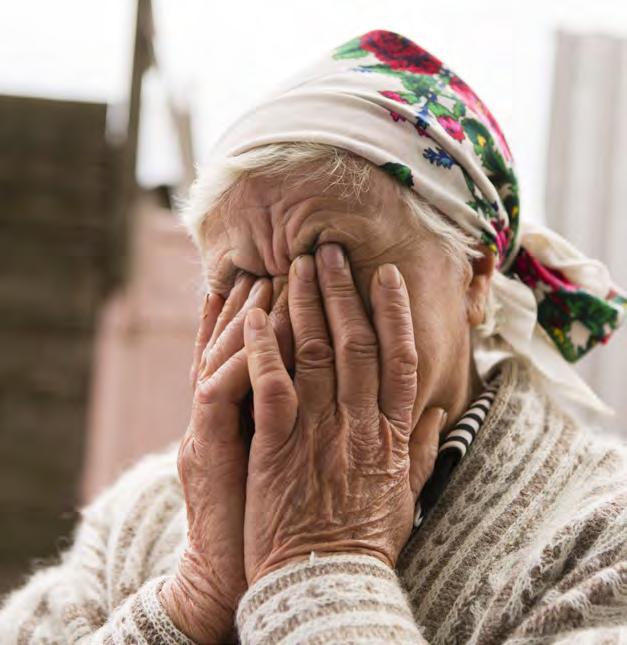 © Maurice Ressel
© Maurice Ressel
In 2016, three Médecins Sans Frontières mobile teams... carried out close to 21,000 medical consultations and around 2,600 mental health consultations in 26 different locationsDONETSK
KEY ACTIVITIES: Emergency medicine, medical donations, response to outbreaks, surgery
After nearly two years of war in Yemen, the medical and humanitarian situation is extremely serious and deteriorating.
Ongoing air strikes and fighting cause daily casualties and frequent damage to civilian infrastructure, hampering humanitarian assistance. Since the conflict began in 2014, the number of people displaced inside Yemen has grown to approximately two million.
In the governorate of Ibb, Médecins Sans Frontières has been working with the Yemeni Ministry of Health and Population to provide medical care in the emergency room of Ibb Al Thawra hospital since the beginning of 2016. The teams have substantially improved the emergency response procedures and boosted quality of care, as well as donating drugs and medical equipment. More than 41,200 patients were admitted to the emergency room in 2016. Our teams also provided training for local staff, including for mass casualty and epidemic response.
Amran
Many people who have fled conflict in other parts of Yemen settle in the relatively calm Amran governorate. In this area, we donate medicines and provide logistical support to four medical facilities, as well as running referral systems to Al-Salam hospital. In this hospital, Médecins Sans Frontières staff work in the emergency room, operating theatre, maternity ward, therapeutic feeding centre, paediatric ward, laboratory and blood bank. A total of 29,212 people attended the emergency room in 2016. Our teams also set up mobile clinics providing malaria and scabies treatment for displaced people in the area.
In Sana’a, Médecins Sans Frontières donates medicines and medical
equipment to Al-Kuwait hospital, one of the main medical facilities in the city, as well as providing maintenance and technical training. We also support the national blood bank, distributing more than 21,184 units of blood to the hospitals in Sana’a in 2016.
Médecins Sans Frontières continued to run our emergency surgical hospital in Aden, providing lifesaving healthcare to thousands of people including victims of mines and unexploded ordnances. In 2016, 5,790 patients were admitted to the emergency room, including people from various southern governorates such as Taiz, Lahj, Abyan, Ad Dhale and Shabwa. The facility also provides mental health
FUNDING: $6,124,746
FIELD STAFF: 718
KEY MEDICAL FIGURE: 41,200 emergency room consultations in Ibb
care and physiotherapy. In October 2016, we supported the Ministry of Health when a cholera epidemic broke out in Aden, providing training and material donations. Our teams also support the national blood bank in Aden, as well as supporting Lawdar Hospital in the neighbouring governorate of Abyan.
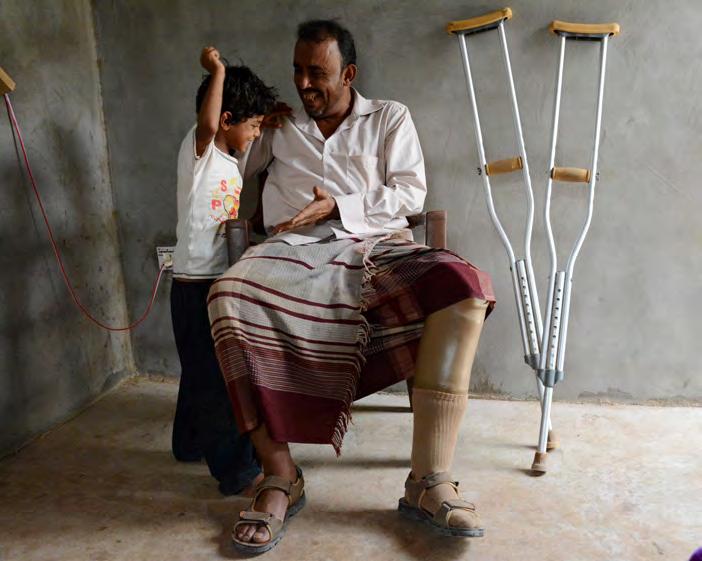
The governorate of Sa’ada, on the border with Saudi Arabia, is one of the most under-resourced and insecure parts of the country. In 2015, we began supporting emergency and maternity care in Haydan, a small village near the front line, but withdrew in August 2016 after a nearby hospital also run by Médecins Sans Frontières was bombed. Our teams returned in February 2017. Further east, we also support the health centres of Noushur and Yasnim.
Mocktar lost his leg when he stepped on a landmine. After receiving surgery and a prosthetic leg from Médecins Sans Frontières he now works with us as a psychosocial supporter. © Malak Shaher/MSF

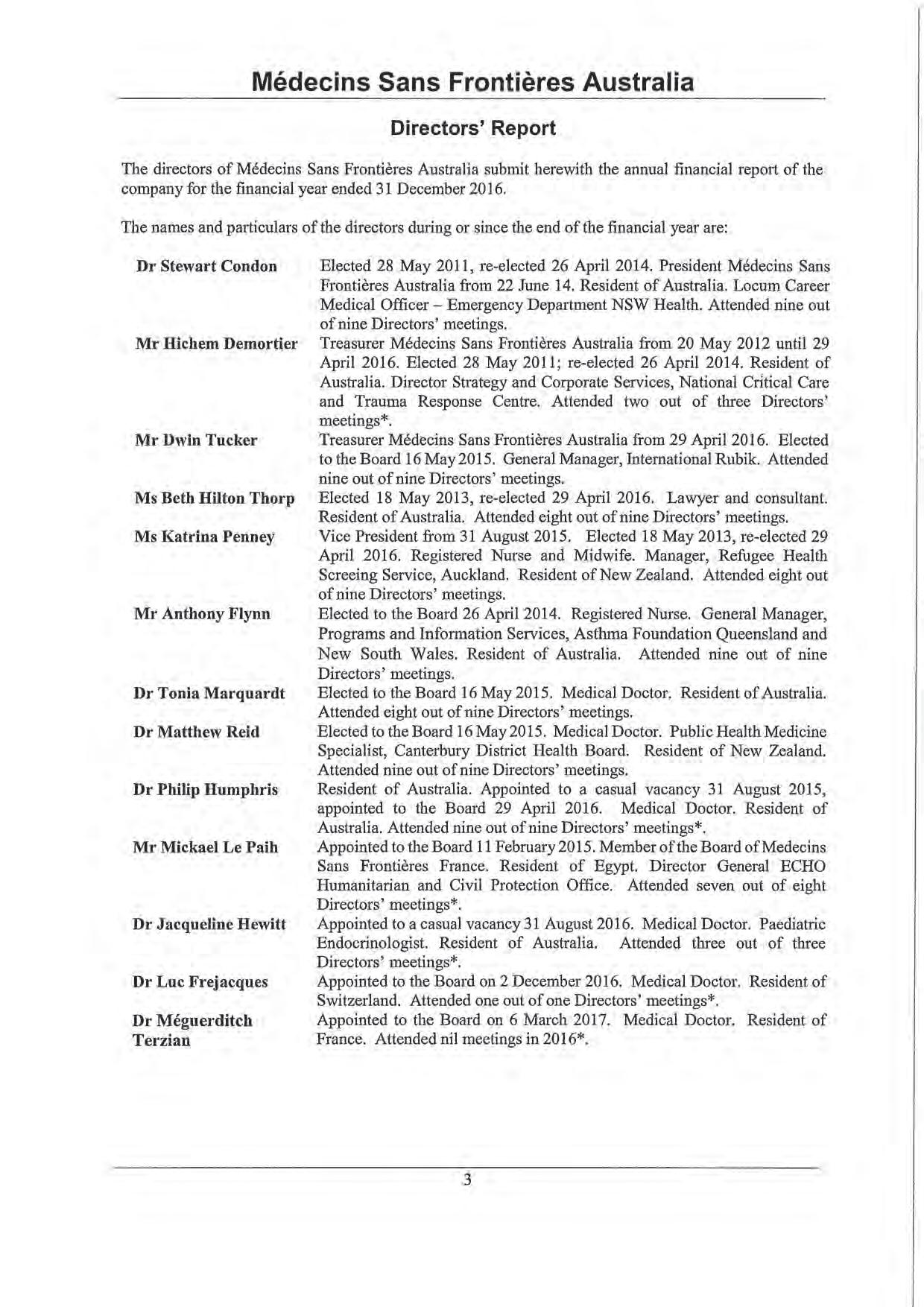

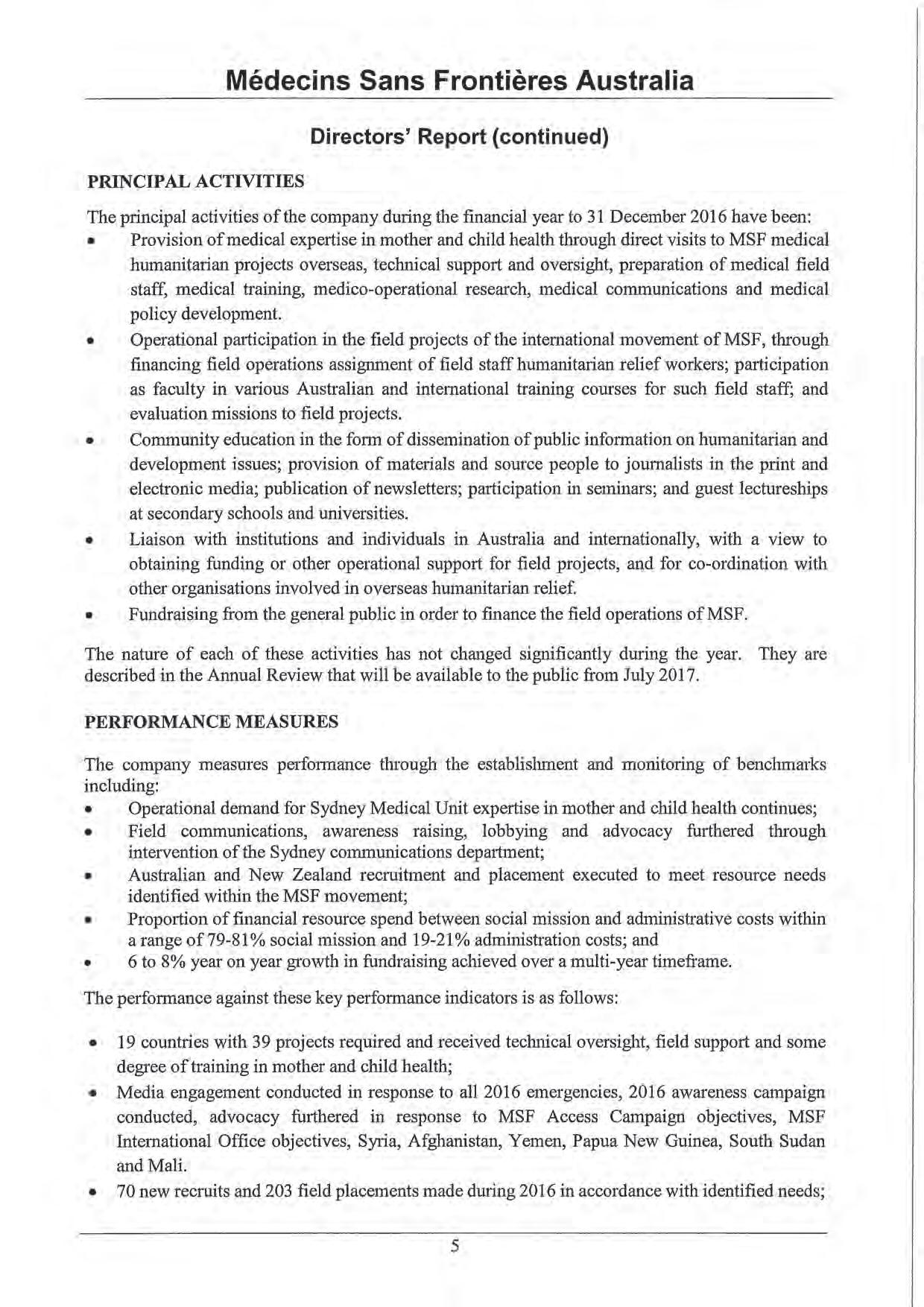


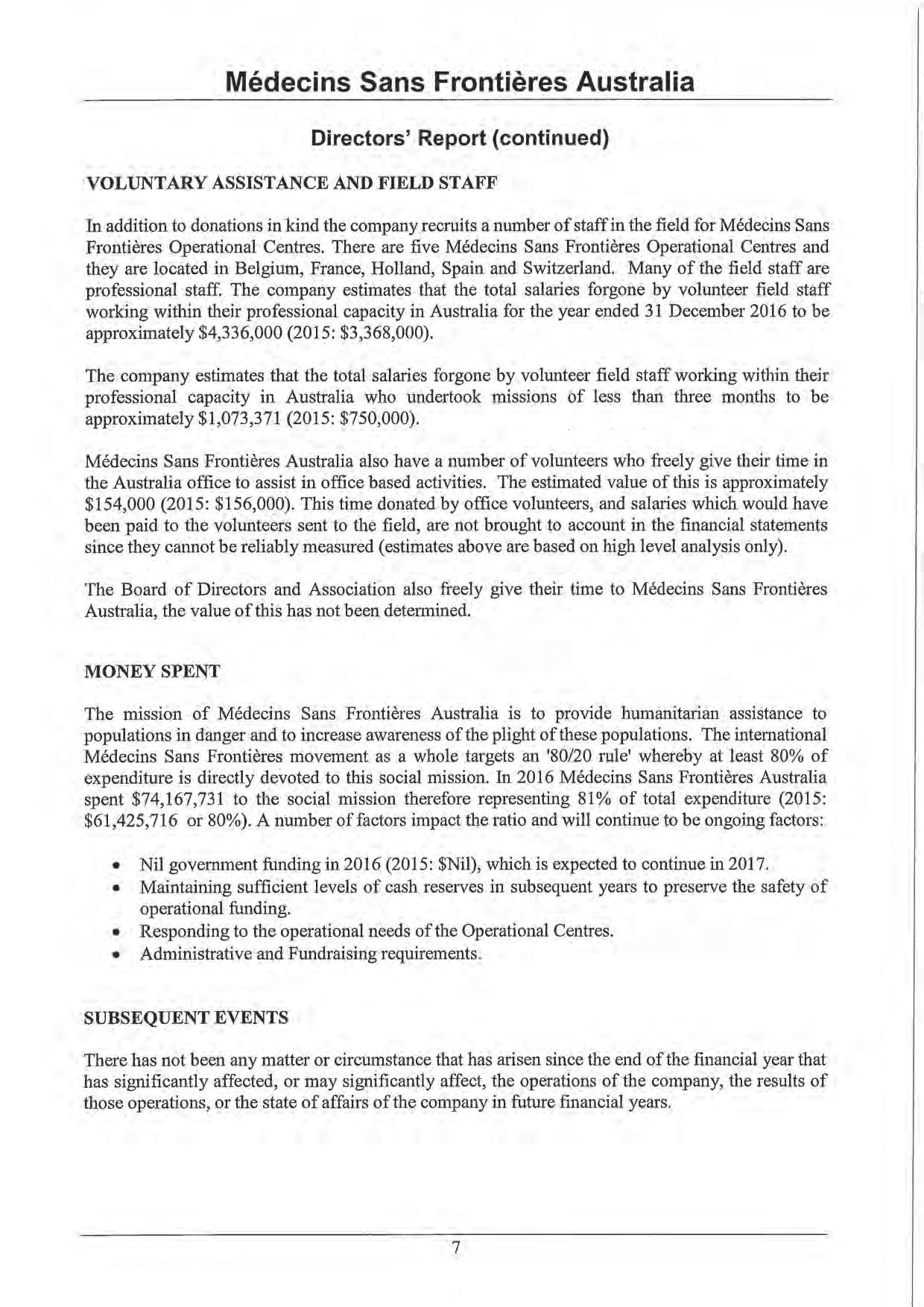
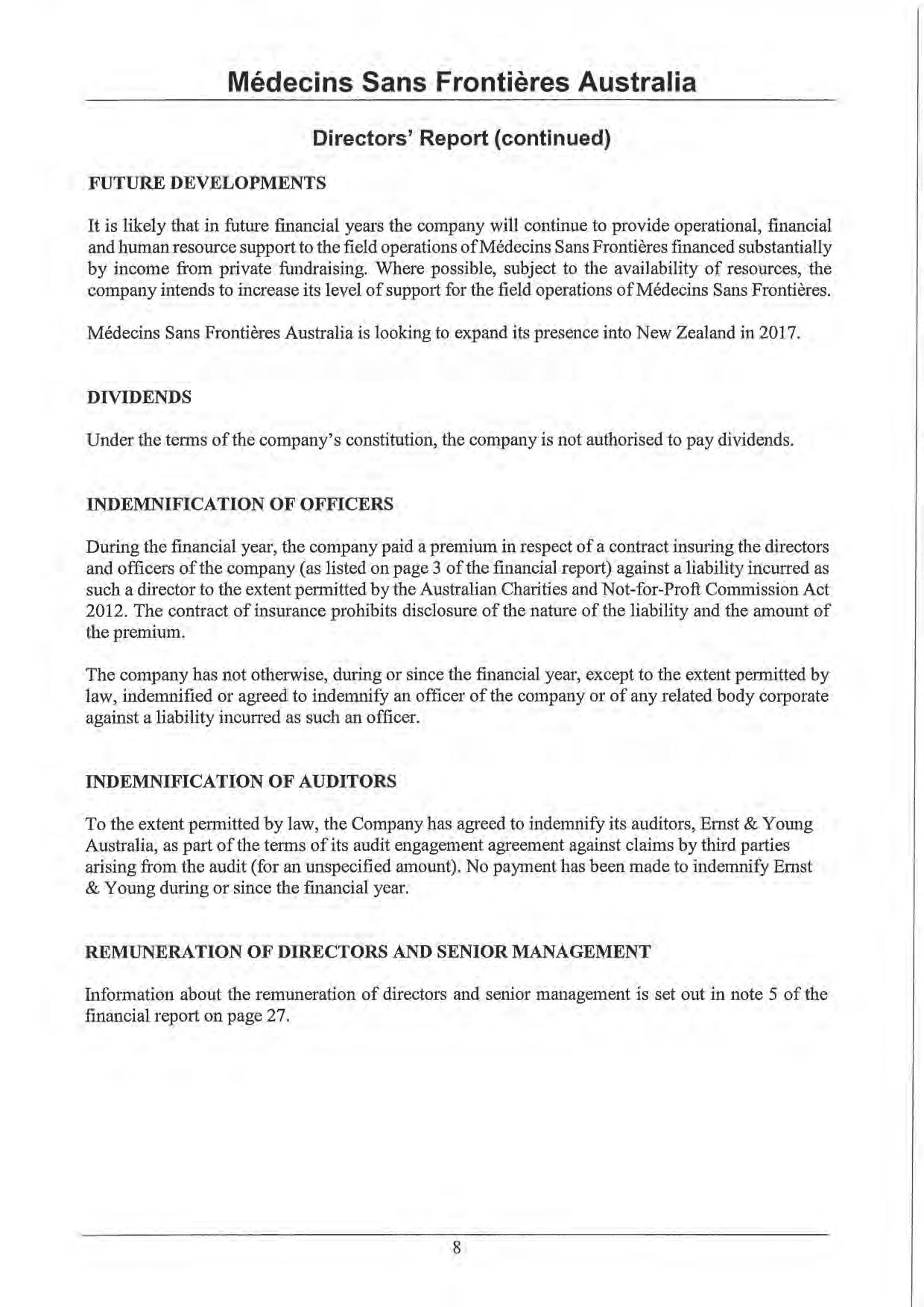
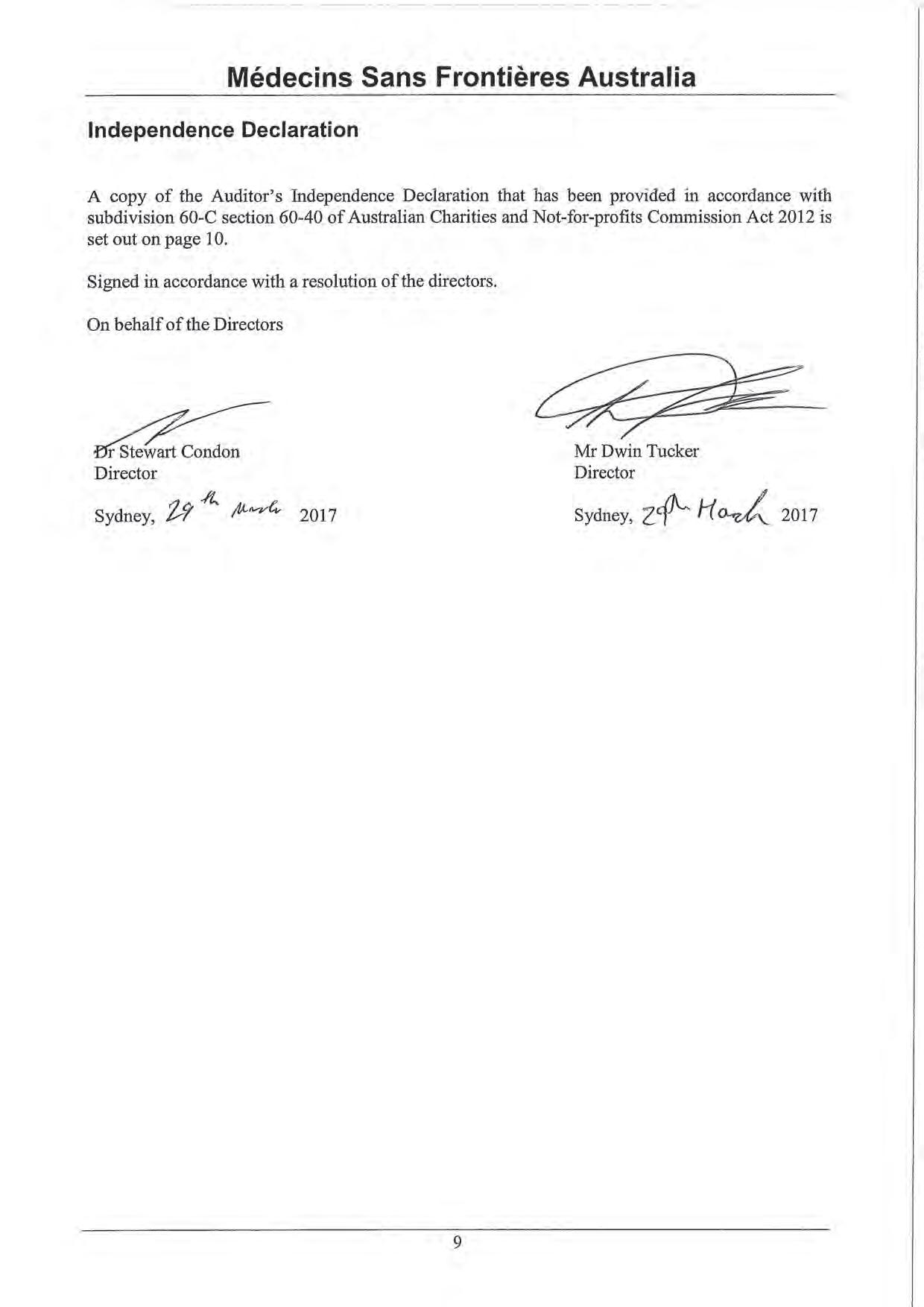






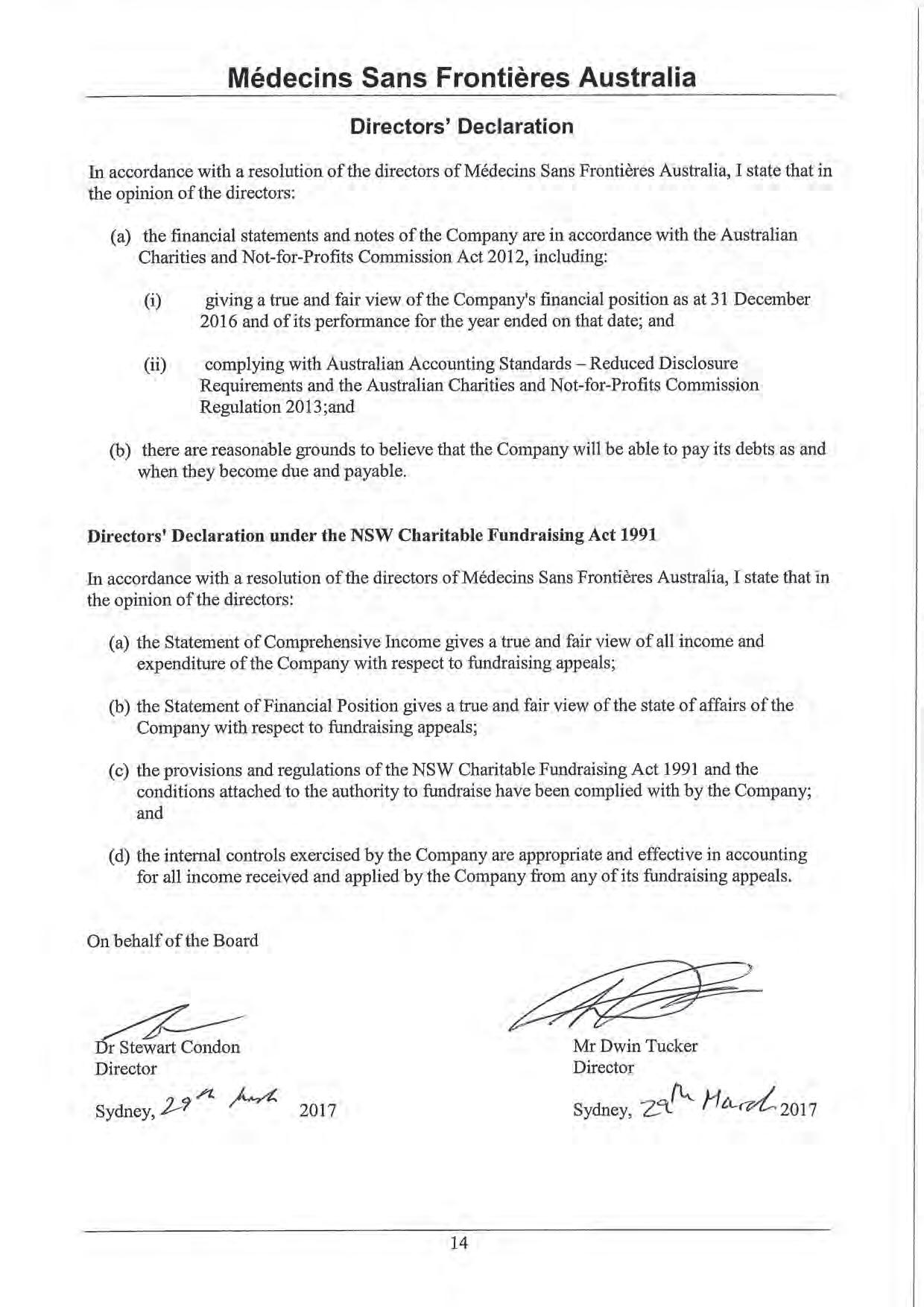

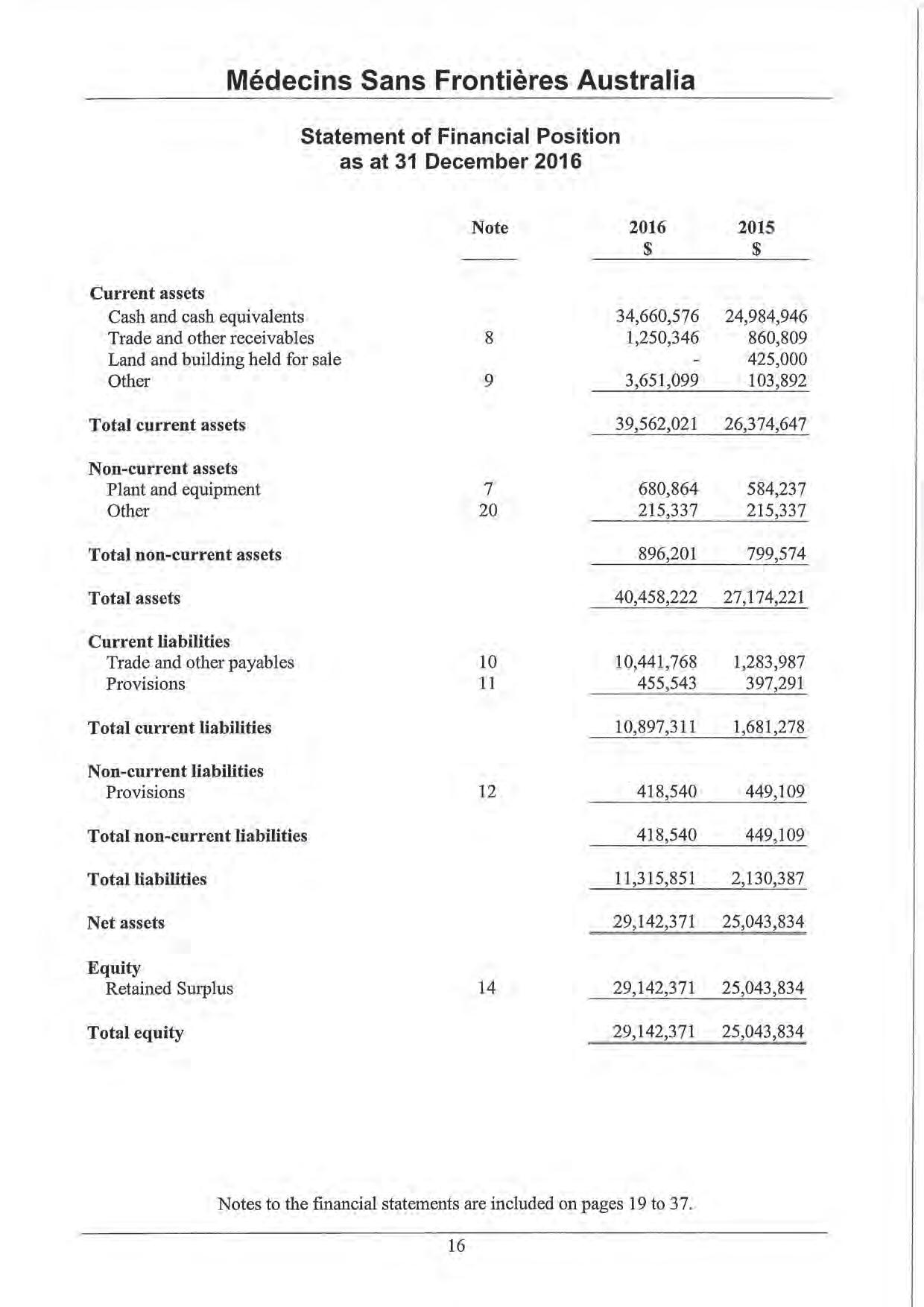



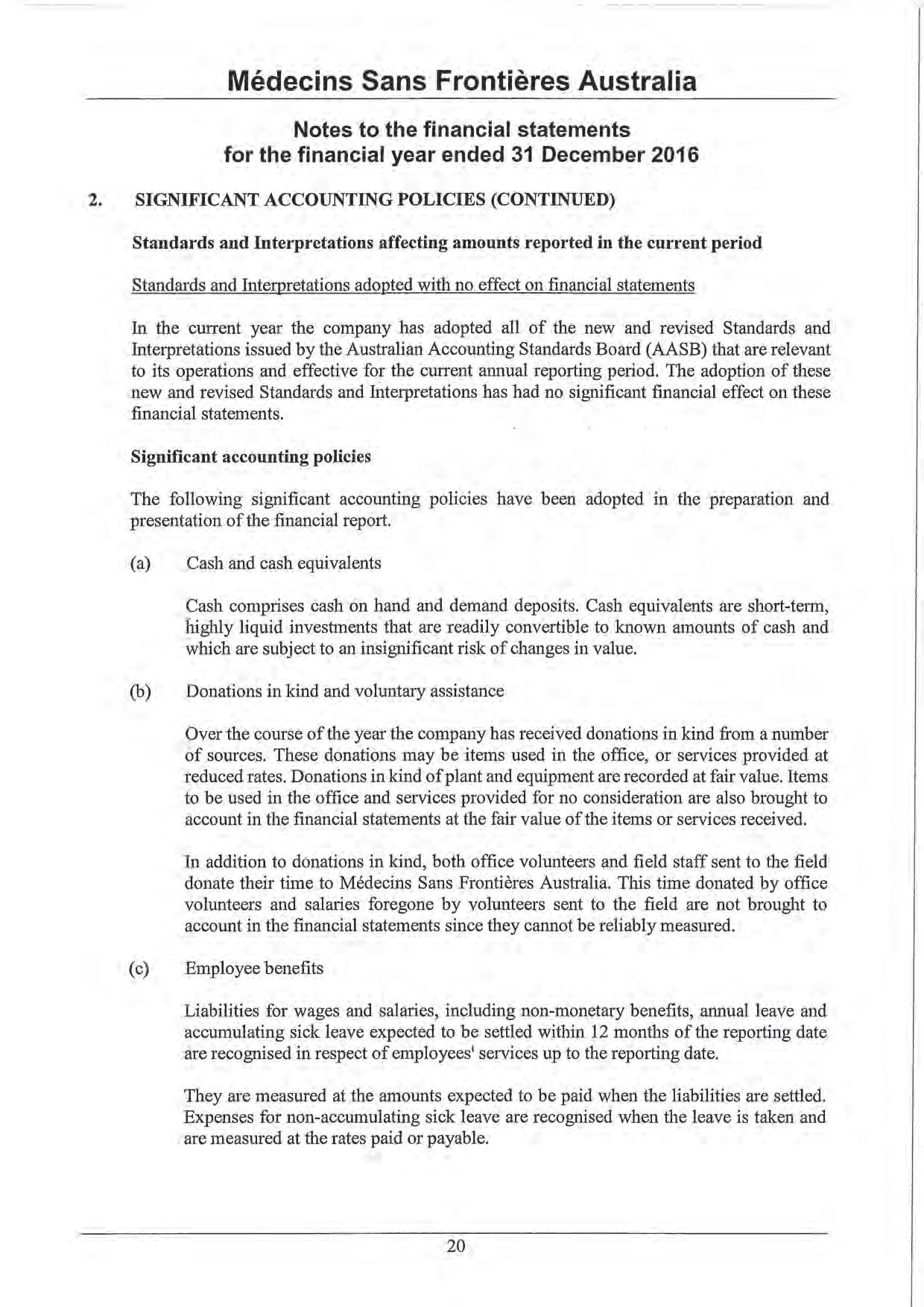

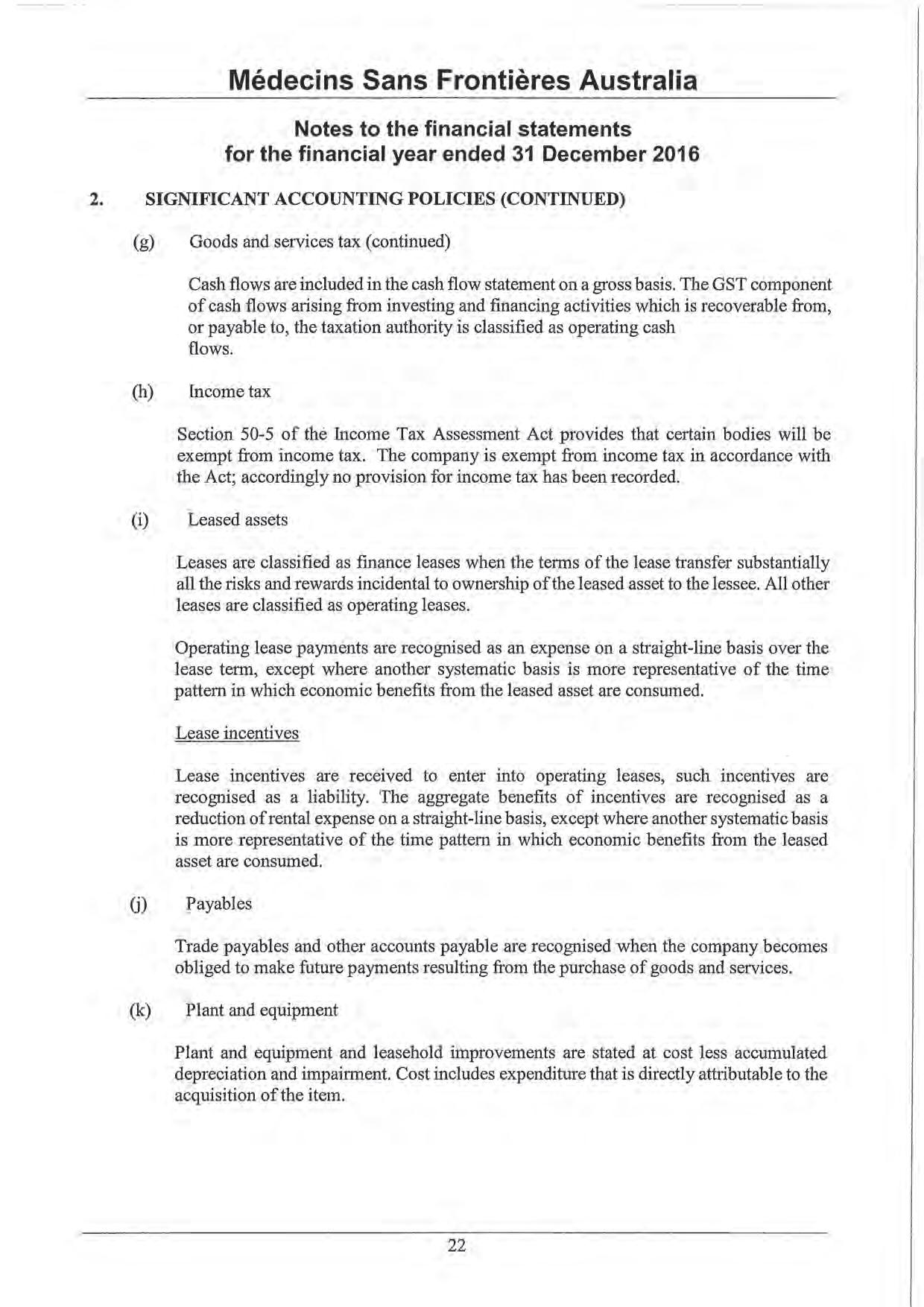
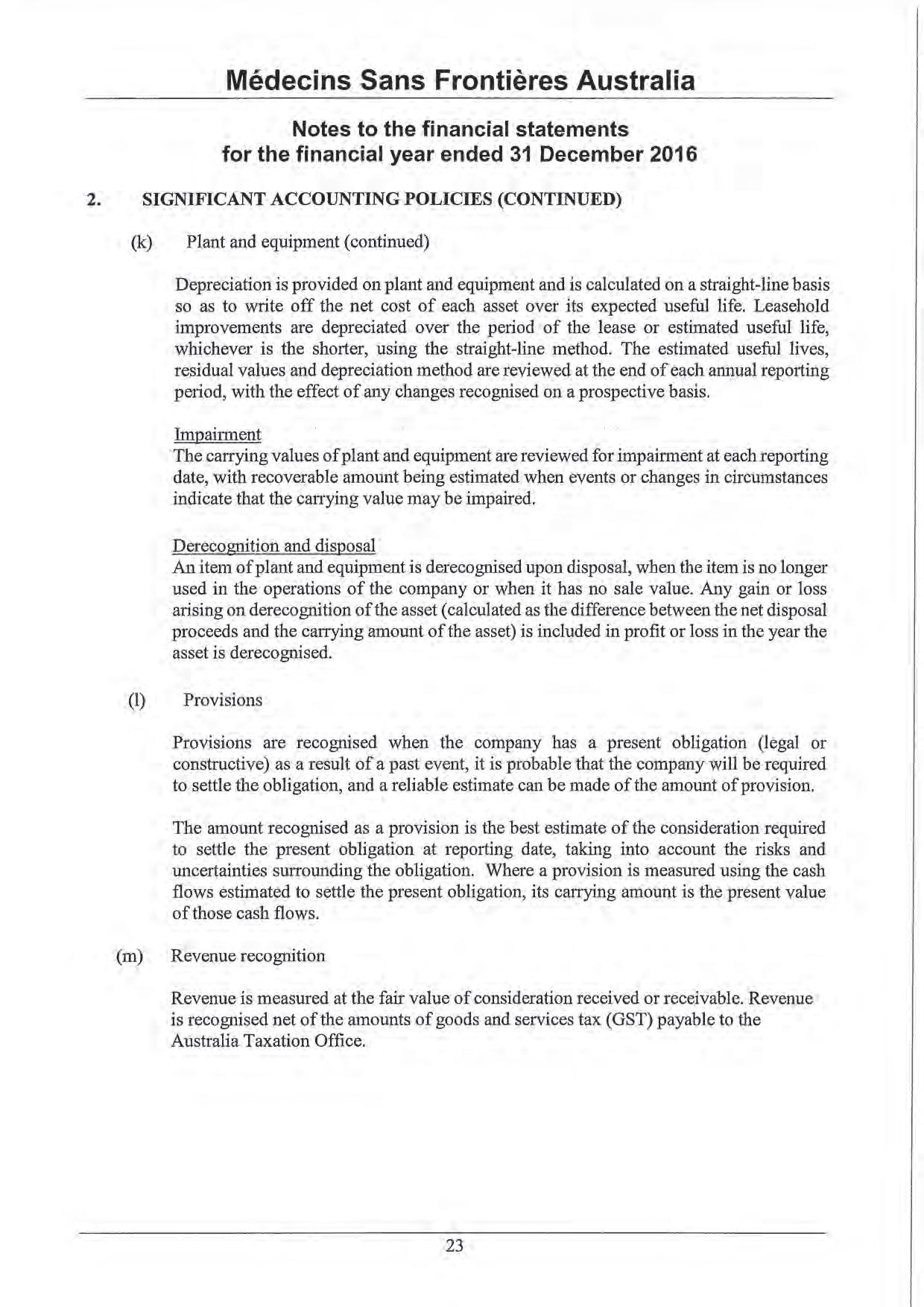
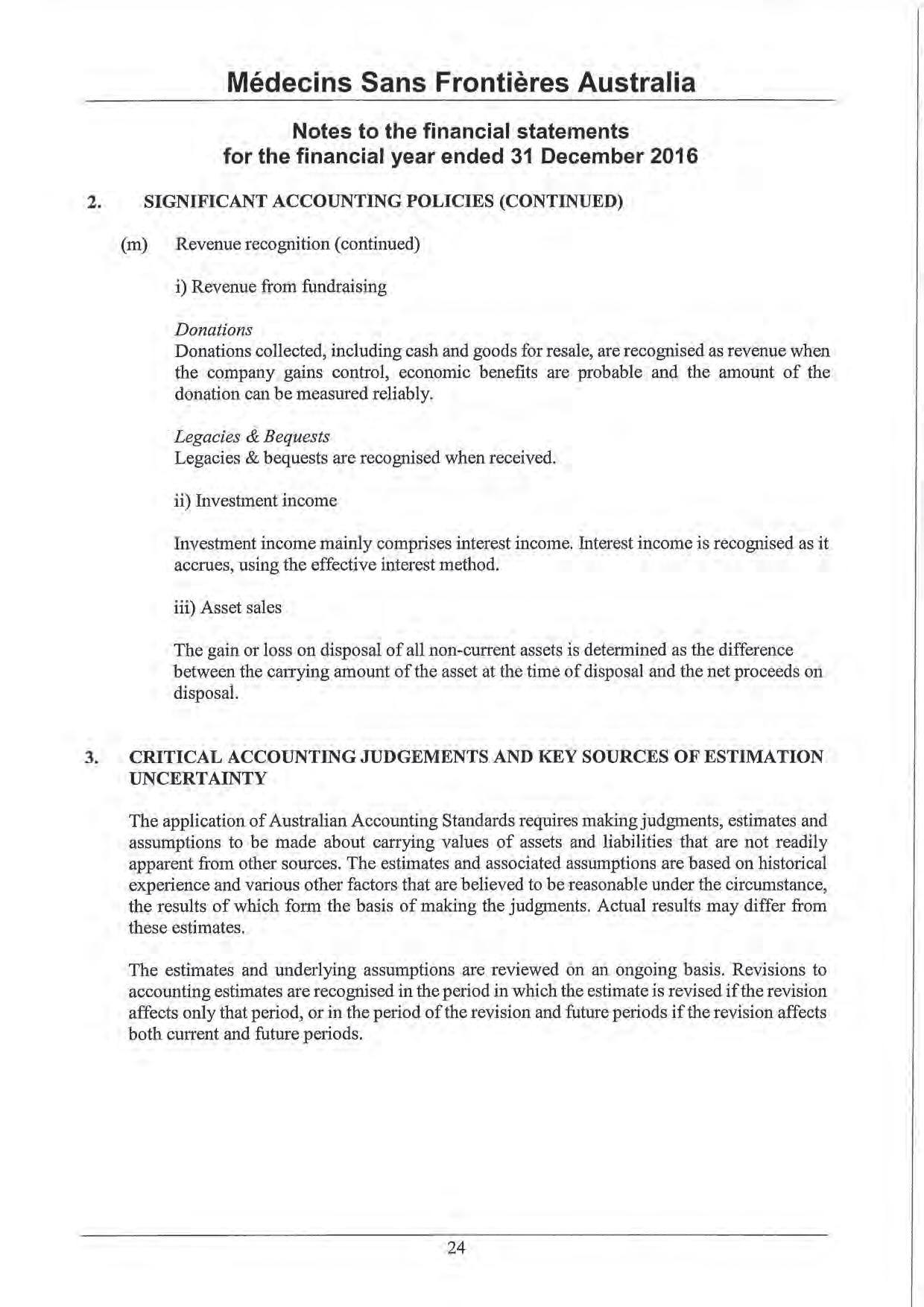


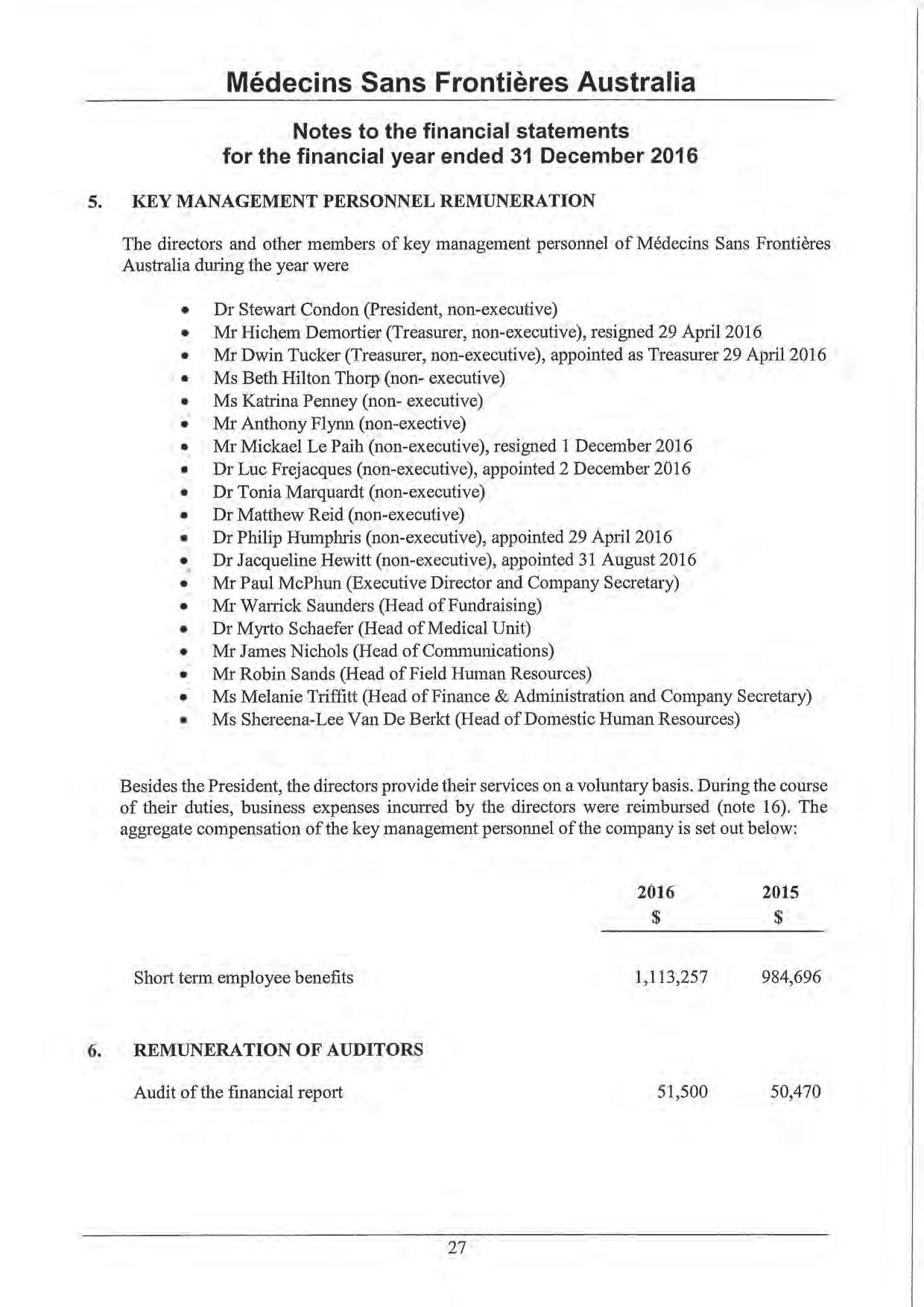


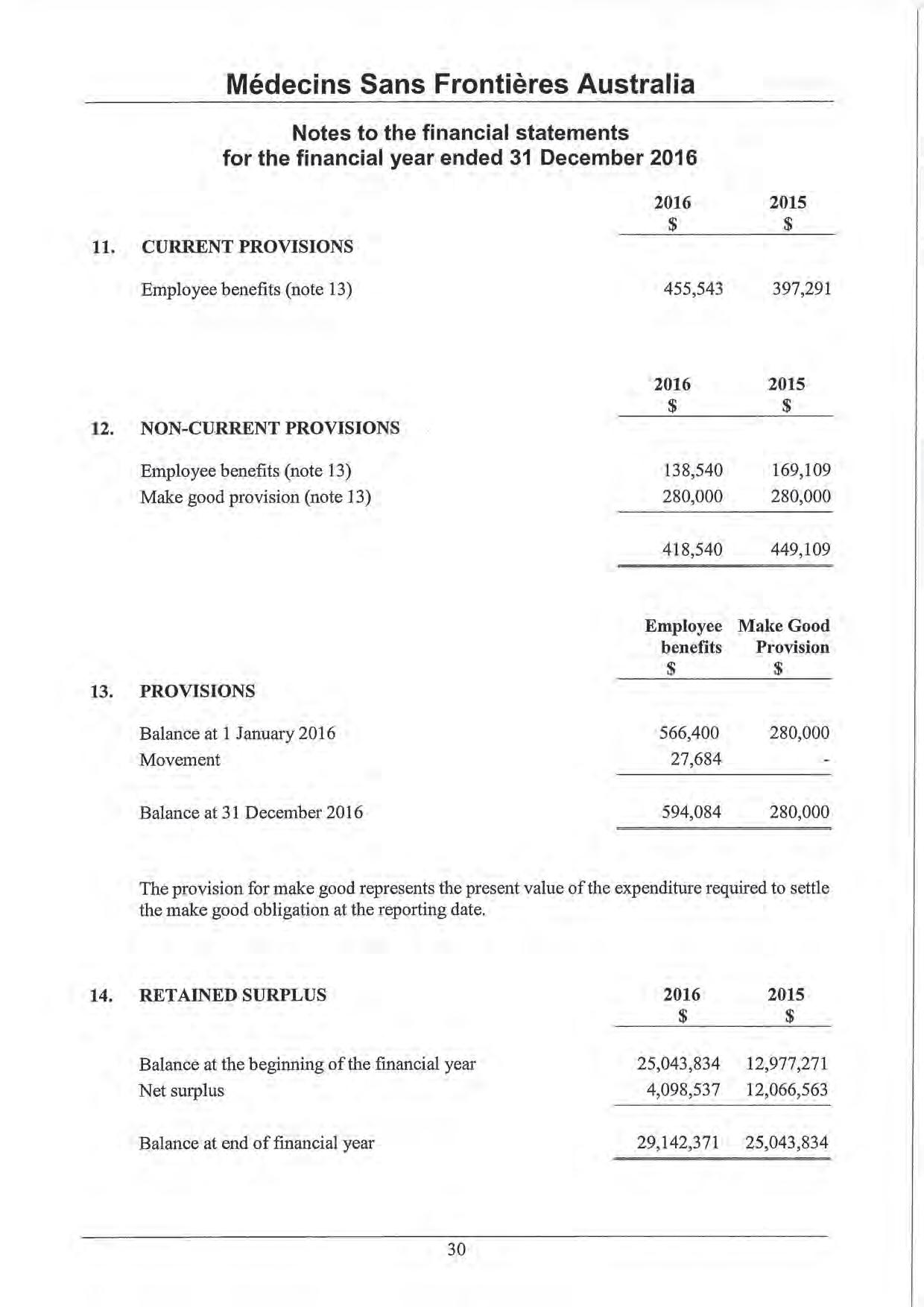
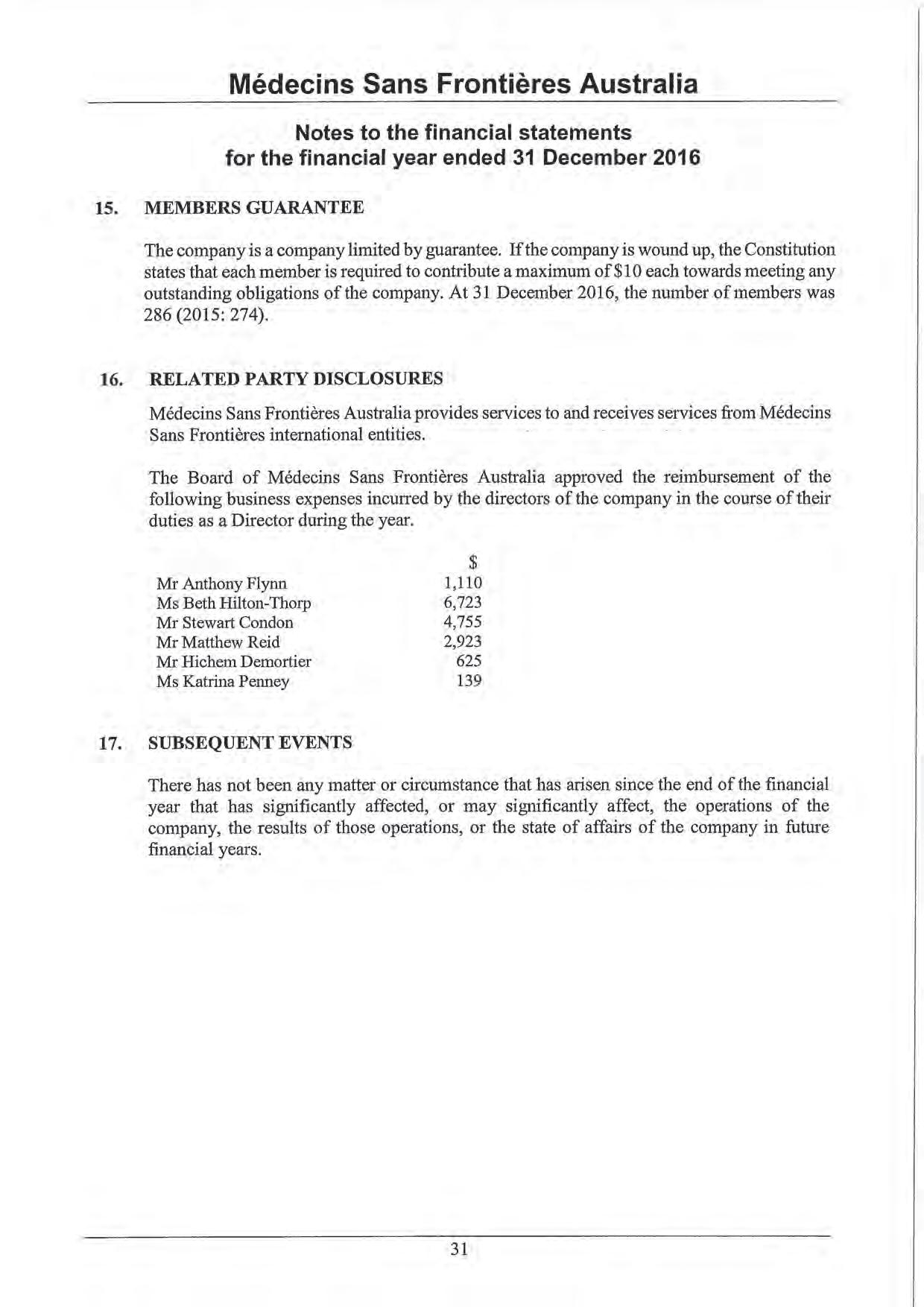






This page is intentionally blank.
Médecins Sans Frontières Australia
ABN 74 068 758 654
PO Box 847, Broadway NSW 2007, Australia
Phone: +61 2 8570 2600
1300 136 061
Fax: +61 2 8570 2699
Email: office@sydney.msf.org
© 2014 Médecins Sans Frontières Australia
www.msf.org.au